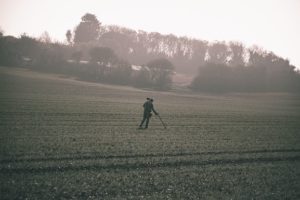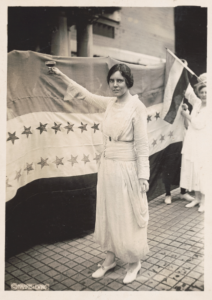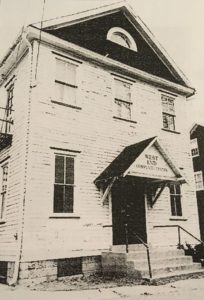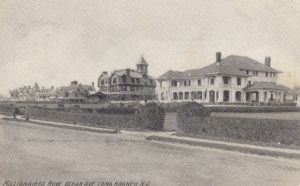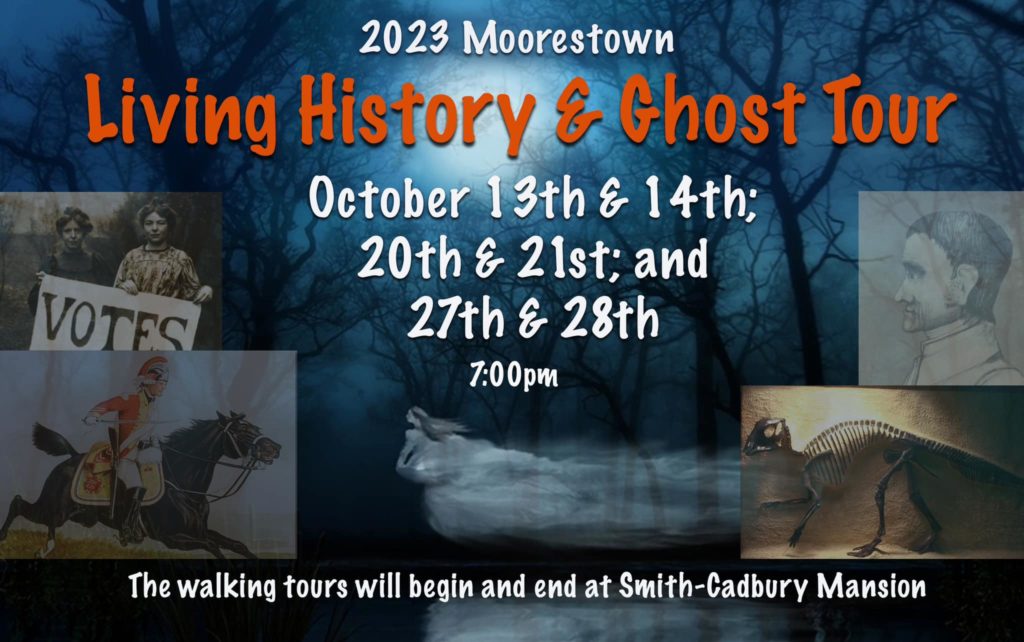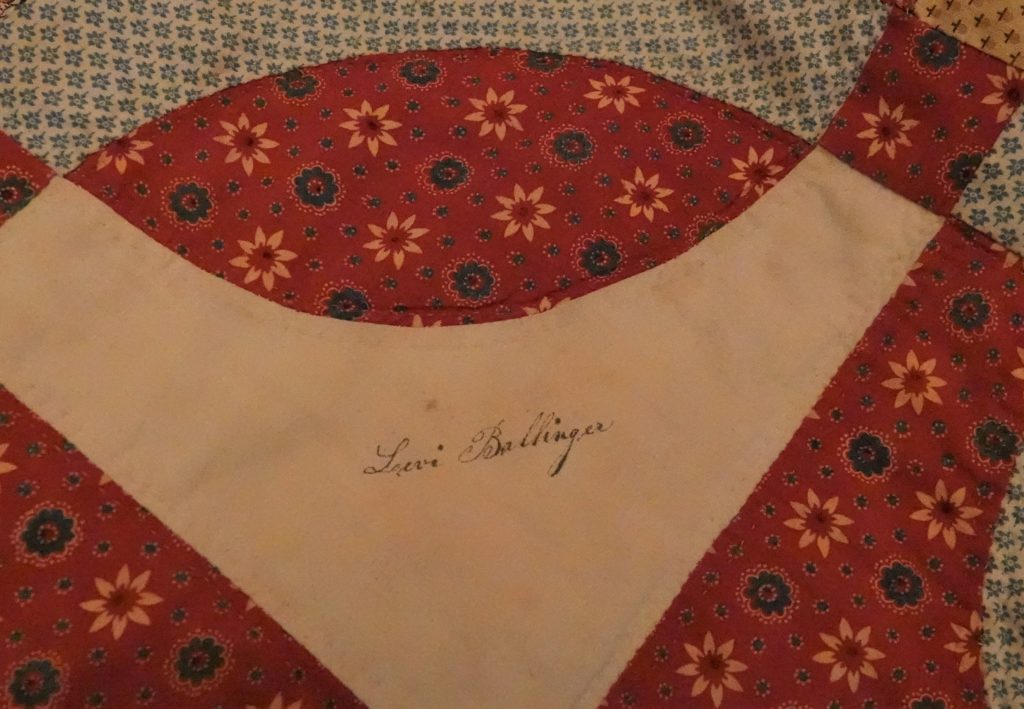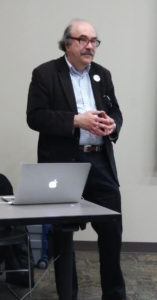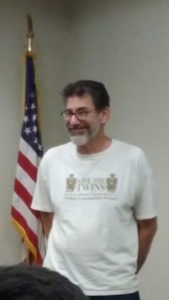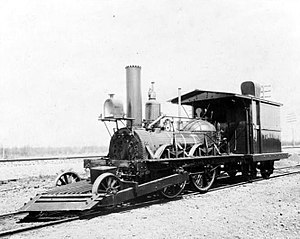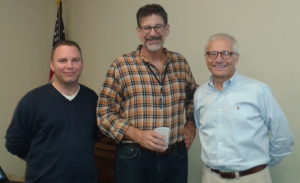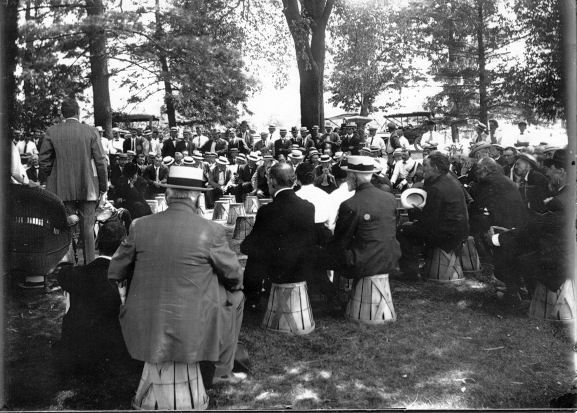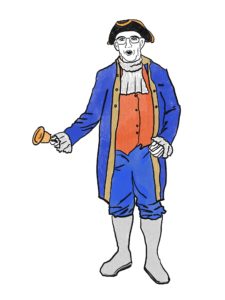A History of Inventing in New Jersey: From Thomas Edison to the Ice Cream Cone
with Linda Barth
Monday June 2, 2025
Moorestown Library
Many people are familiar with Edison’s “invention factory” in Menlo Park, where he patented the phonograph, the light bulb, and many more innovations. Yet many other ideas have grown in the Garden State, too—New Jerseyans brought sound and music to movies and built the very first drive-in theater. In addition to the first cultivated blueberry, tasty treats like ice cream cones and M&M’s® are also Jersey natives. Iconic aspects of American life, like Bubble Wrap®, the boardwalk, the Band-Aid®, and even professional baseball itself started in New Jersey. Life would be a lot harder without the vacuum cleaner, plastic, and air-conditioning, and many other important advances in medicine and surgery were developed here. Join author Linda Barth as she explores groundbreaking, useful, fun, and even silly inventions and their New Jersey roots.
A lifelong resident of the Garden State, Linda Barth has written two books on the D&R Canal and three children’s picture books, Bridgetender’s Boy, Hidden New Jersey, and Alice Paul: Champion of Women’s Rights. She has also authored A History of Inventing in New Jersey: From Thomas Edison to the Ice Cream Cone and New Jersey Originals. With her husband she has published The Millstone Valley Through Time and Somerville Through Time. She has also contributed to the Encyclopedia of New Jersey.
Linda spent 45 years in the Bridgewater-Raritan School District, teaching fourth grade and then substituting after retirement. She is the executive director of the League of Historical Societies of New Jersey and president of the D&R Canal Watch, a friends organization of the D&R Canal State Park.
This program is part of the New Jersey Speaks Lecture Series; to register click here.
The Following events have already occurred.
Saving Historic Moorestown: What Style is It? Eclectic Building 1880-1940
with Dorothy Guzzo
Tuesday April 29th, 2025
Moorestown Library
Have you ever wondered why your house looks the way it does? This lecture series is designed to acquaint the learner with the development of domestic architecture through high style examples and vernacular interpretation. Organized by time period, learn to identify architectural features, forms and materials that characterize specific influences and help to date homes.
The homes from this time period reflect the growing middle class and affordability of the single-family home coupled with the ability to ‘order’ your house from a catalog. Domestic innovation reduced the need for ‘staff’ to maintain the house, and influenced the practical size and configurations during this period. Eclectic styles to be explored include Craftsman, Art Deco, Art Moderne, Colonial Revival, Neoclassical, Tudor, and Mediterranean.
Presenter Dorothy P. Guzzo is the Vice President of Saving Historic Moorestown. Prior to her retirement, she was the Executive Director of the New Jersey Historic Trust. Previously, Ms. Guzzo was the Deputy State Historic Preservation Officer (DSHPO) and Administrator of the State’s Historic Preservation Office. Her career spans over 35 years in historic preservation serving in numerous capacities. She is an adjunct with Rutgers University, Certificate in Historic Preservation Program. She is the recipient of Preservation New Jersey’s Sarah P. Fiske Legacy Award for her lifetime devotion to historic preservation. She has resided in Moorestown since 1996.
To register, click here.
This talk is presented by Saving Historic Moorestown. To read about the organization, click here.
The Following events have already occurred.
A Shot Heard Round the World: Spreading the News of April 19, 1775
with Matthew Skic
Monday April 21st, 2025
Moorestown Library
Everyone knows that the American Revolution began with the Battle of Lexington and Concord which occurred on April 19, 1775 but when did the people of the Delaware Valley get the news about the “shot heard round the world”? Here is a hint- when Matt Skic, curator of the Museum of the American Revolution, speaks about “The Day the Revolution Started” at the library on April 21st, it will be almost the 250th anniversary of that momentous day. This event is part of the Historical Society of Moorestown’s New Jersey History Speaks Lecture Series. To register, click here.
The Following events have already occurred.
Facts and Artifacts
with Dave Bouldon
Tuesday March 25th, 2025
Moorestown Library
Local historian David Bouldon returns to provide an update on his never ending quest to research the comings and goings of the British Army in Burlington and Camden County during the American Revolution. His compelling journey involves metal detecting to research the British Army’s activities in our area. This expedition and study cover both Camden and Burlington Counties, NJ. The focal locations are, but not limited to, the evacuation route the British Army took from Philadelphia through NJ in June 1778. This program is part of the New Jersey Speaks Lecture Series. To register, click here.
They Were Good Soldiers: African Americans Serving in the Continental Army, 1775-1783 with John U. Rees
Wednesday February 12th, 2025 7-8pm
Moorestown Library
Historian John U. Rees will speak about his book: They Were Good Soldiers: African Americans Serving in the Continental Army, 1775-1783 which examines the role of African-Americans, most free but some enslaved, in the regiments of the Continental Army.
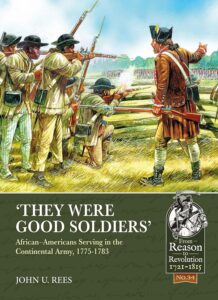
They Were Good Soldiers begins by discussing, for comparison, the inclusion and treatment of black Americans by the various Crown forces (particularly British and Loyalist commanders, and military units). The narrative then moves into an overview of black soldiers in the Continental Army, before examining their service state by state. Each state chapter looks first at the Continental regiments in that state’s contingent throughout the war, and then adds interesting black soldiers’ pension narratives or portions thereof. The premise is to introduce the reader to the men’s wartime duties and experiences. The book’s concluding chapters examine veterans’ postwar fortunes in a changing society and the effect of increasing racial bias in the late eighteenth and early nineteenth centuries.
‘They Were Good Soldiers’ makes extensive use of black veterans’ pension narratives to ‘hear’ them and others tell their stories, and provides insights into their lives, before, during, and after the war.
John U. Rees has been writing about the common soldiers’ experiences in the War for American Independence for over thirty years, on subjects ranging from army food and the soldier’s burden, to women with the army, and military vehicles and watercraft. His work may be viewed at ‘World of the Common Soldier’.
This program is part of the New Jersey Speaks Lecture Series.
To register click here.
The Following events have already occurred.
Moorestown Suffragist Movement
with Gary Ell
Thursday January 30th, 2025 7-8pm
Moorestown Library
Gary Ell, member of the Historical Society’s Board of Trustees, will speak on a new project which will shed light on the early suffrage movement in Moorestown.
Gary has identified about a dozen early Suffragists from Moorestown that inspired twelve year old Alice Paul. He has also discovered key moments in the suffrage movement that occurred in Moorestown, such as formation of the Moorestown Equal Suffrage League in 1897, the “key” reorganization of the NJWSA in 1900 – at City Hall in Moorestown. Gary will discuss Alice Paul’s return to Moorestown after having been imprisoned in UK, where she addressed 500 people at City Hall and Moorestown Friends School, that set the direction of the new movement. Additionally, the lecture will cover the incorporation of the National Grange and WCTU into Suffrage Movement with the work of Catherine B Lippincott; and finally, the culmination: the voting of Alice in 1920 with her 141 Chestnut St. address.
Moorestonians were the movers and shakers of the movement in local, state, national and even global affairs. Gary has compiled extensive research on their endeavors leading to the passing of the 19th Amendment and beyond.
This program is part of the New Jersey Speaks Lecture Series.
To register click here.
The following events have already occurred.
History Talk: Remembering the West End Center Part II
Tuesday December 3rd, 2024 7-8:30pm
Moorestown Library
The Historical Society of Moorestown invites you to join us for an update and engaging conversation about our West End Center Oral History Project. Attendees will hear directly from the project team about our progress preserving the history and legacy of the West End Community Center, which served as the social and cultural hub for Moorestown’s once segregated West End neighborhood from 1944-1968. Learn about the new public resources we developed, including recordings of Black elders and digitized original records.
Attendees are encouraged to bring any personal stories, photos, correspondence, and/or newspaper clippings about The West End Community Center. The Historical Society will have recording and scanning equipment at the event to document any treasures you want to contribute to this important project. Materials can be scanned and returned immediately. The team is specifically seeking materials from the 1940’s and early 1950’s, but will gladly accept materials from any time period.
If you have questions, please contact The Historical Society of Moorestown at (856) 235-0353 or email moorestownhistory@comcast.net.
To register click here.
The following events have already occurred.
Playing With the Best: One Man’s Journey Through the Golden Age of Sports
with Lenny Wagner
Monday October 7th at 7pm
Moorestown Library
The Historical Society of Moorestown’s President, Lenny Wagner, will speak about his recently released book on the life and times of Walter French called “Playing With the Best: One Man’s Journey Through the Golden Age of Sports” at our Annual Meeting.

Before Bo Jackson and Deion Sanders, there were only nineteen men, throughout history, who played in the Major Leagues of baseball and in the National Football League, in the same season. Only one man from that group, Moorestown’s own Walter French, can lay claim to having played for a World Series winner and an NFL Championship team. In 1925, he starred for the Pottsville (PA) Maroons in their win over the Chicago Cardinals, in what was believed to be the NFL championship game, only to see the title stripped by a league office decision, a controversial move still being argued about today. Then in 1929, he was on the Philadelphia Athletics when they beat the Chicago Cubs in five games to win the World Series.
Born in Moorestown in 1899 Walter was a direct descendent of one of the town’s original founders, Thomas French. He played with and against the biggest stars the decade of the 1920s had to offer, including Babe Ruth, Lou Gehrig, Walter Johnson, Ty Cobb, and twenty-seven other ballplayers who would eventually wind up in the Baseball Hall of Fame. In football, he went up against the likes of Notre Dame’s George Gipp, the “Four Horsemen,” Curly Lambeau, George Halas, Ira “Buck” Rogers and many more. The top sports writers of his day, from Grantland Rice to Ed Sullivan, made regular mention of him in their columns. Other well-known figures from the period such as Paul Robeson, Knute Rockne, Connie Mack, and General Douglas MacArthur all make appearances in Wagner’s book
The book is being published by Brookline Books, an imprint of Casemate Publishing, and will be available for purchase. For more information and to purchase the book go to Playing With The Best.
To register, click here.
This event is part of the Historical Society’s New Jersey History Speaks Lecture Series.
The following events have already occurred.
Written with Bricks: A Guide to New Jersey’s Pattern Brick Architecture
with Matthew Skic
Wednesday September 4th at 7pm
Moorestown Library
Matthew Skic will speak on his latest project entitled “Written with Bricks: A Guide to New Jersey’s Pattern Brick Architecture.” As a native New Jerseyan (and resident of Moorestown since 2021), Matthew has long been fascinated by NJ’s distinctive pattern brick structures from the 18th and early 19th Centuries. They are a truly special part of NJ’s architectural heritage.
Matthew Skic grew up in Hopewell, New Jersey, where he developed a passion for early American history, specifically the American Revolution. At the age of 16, Matthew got his first job as a historical interpreter at Washington Crossing State Park. He went on to study history at American University and earned his master’s degree from the Winterthur Program in American Material Culture at the University of Delaware. In 2016, he joined the staff at the Museum of the American Revolution in Philadelphia, where he now serves as Curator of Exhibitions. Matthew was also awarded a scholarship in 2022 to attend the Attingham Trust’s Summer School, an intensive program for the study of British country estates and their collections. Tonight, Matthew will publicly launch his latest project, “Written with Bricks: A Guide to New Jersey’s Pattern Brick Architecture.”
To register, click here.
This program is part of the Historical Society of Moorestown’s “New Jersey History Speaks” Lecture Series
The following events have already occurred.
Moorestown True Crime Story: Annie McCormick’s “Restless Ghosts”
June 5th, 7pm
Moorestown Library
Lovers of true crime drama will not want to miss the next talk in the Historical Society of Moorestown’s “New Jersey History Speaks” Lecture Series. Annie McCormick, news reporter on ABC’s Philadelphia affiliate Channel 6, will discuss her latest book “Restless Ghosts”. In 1929 famed Burlington County Detective and the man referred to as the American Sherlock Holmes, Ellis Parker was called to Moorestown to solve what he believed was the murder-suicide of a young couple.
However, his investigation was shrouded in controversy over whether money and privilege influenced his findings. Rumors swirled that the couple was murdered. A childhood friend of the couple is heard at speakeasies implying he knew who did it. Nearly four years later that young man is found shot to death and Parker is once again assigned the case. While Parker investigates the newest killing the 1929 case is re-opened. Will Parker be able to give the families closure or will the victims remain Restless Ghosts?
For adults.
Registration is required. To register, click here.
The following events have already occurred.
Historic Preservation Public Workshop
May 29th, 7pm
Location: Moorestown Town Hall & Online
Moorestown is exploring the creation of an historic district focused on commercial properties along central Main Street and part of Chester Avenue. This initiative will be overseen by a commission to ensure these properties preserve their historical character and continue to enrich our community’s cultural heritage.
Share your thoughts and complete the Public Survey!
Attend the Public Workshop to learn more!
This workshop will cover The Basics of Historic Preservation; Proposed Historic District & Sites; Historic Preservation Ordinance; Q&A Session
Of Dusk and Death-Rays: A Reflection on Architecture and Change
with William Whitaker
Monday April 29, 2024, 7pm
Moorestown Library
What makes a building a valuable part of a community, or more broadly, significant in cultural terms? Should one think of landscape and open spaces in the same way? Whether in the neighborhood or in distant locals, built heritage tells the story of culture in solid material terms. And yet, as time goes by, a community’s relationship to its built environment changes. Sometimes the rate of change is barely perceivable over a life time, or it can come more suddenly at an exponential rate.
In this talk, William Whitaker, Curator of Penn’s Architectural Archives, will explore these questions through the work of Louis Kahn, Malcolm Wells, and a number of local landmarks.
To read about William Whitaker click here.
This program is part of the New Jersey History Speaks lecture series.
A brief Board of Trustees Annual Meeting will precede the lecture.
Malcolm Wells: One Man’s Crusade To Save The Environment Through Architecture will be on view at Smith-Cadbury, 12 High St., prior to the meeting from 5 to 6:30 pm.
To register click here.
The following events have already occurred.
Remembering the West End Center with Richard Gray
Wednesday February 20, 2024, 7pm
Moorestown Library
Join us for a lecture with Moorestown native Richard Gray who will review the history of the West End Community Center, and his plan to protect the legacy of a place so important in the history of Moorestown.
The WECC was originated and managed by Black women and men in the West End neighborhood as a space where residents could congregate, celebrate, and create programs to build strong community relationships, in the face of the discriminatory policy which prohibited African-American residents of the town from using the Community House on Main Street.
The WECC was a place of belonging where social ties were deepened through joyful, purposeful interaction. Despite its historical and cultural significance, many Moorestown residents are unaware of WECC, in large part because the building was destroyed after the Community House was eventually integrated in the 1960’s.
Mr. Gray currently is the Director of Community and School Development for the Center for Collaborative Education and a lecturer at the Columbia University Law School.
Click here to register.
This presentation is part of the Historical Society’s New Jersey History Speaks Lecture Series
The following events have already occurred.
The Gilded Age in New Jersey
Melissa Ziobro, Monmouth University
Monday December 11, 2023, 7pm
Moorestown Library
Fans of the popular HBO series, “The Gilded Age” will not want to miss this event! Ms. Melissa Ziobro, Specialist Professor of Public History at Monmouth University, will discuss the privileged lifestyle of the late 19th century, the period Mark Twain labeled, “The Gilded Age.” Americans who achieved great wealth celebrated it as never before. In New York, the opera, the theatre, and lavish parties consumed the ruling class’s leisure hours as the HBO series faithfully depicts, but how did the Gilded Age manifest itself in New Jersey?
Professor Ziobro will discuss tycoons like James B Duke who carved out a 2,000 acre estate, Duke Farms, in 1899, leaving it to his daughter Doris at age 13. Jay Gould needed a retreat in Lakewood for his polo ponies and balls. Millionaires Row at Long Branch drew those who loved the shore for their summer homes. Ladies’ fashions had to be numerous, fine and fancy.
Who were the powerful and influential families in the Garden State in the Gilded Age? “Old money” versus “new money?” Where are they now?
To register for this program click here.
This program is part of the New Jersey History Speaks lecture series.
The following events have already occurred.
Join us for an Autumn evening stroll full of History, Mystery & Ghosts!
This year’s tour is an interactive living history extravaganza featuring local historical figures such as: Alice Paul and the Women’s Rights Activists, John Woolman and the Abolitionists, Edna Woolman Chase (Women’s lib advocate who would become Vogue Editor), Edward Harris, the Marquis de Lafayette, Thomas & Benjamin Moore (two brothers that will tell a brief story about themselves and argue about naming of the town), Elizabeth Coles (the quick-witted girl who outran British Dragoons during the American Revolution), Walter French (famous M’Town baseball player who would go to the big leagues in 1930’s)…. and many more!
Please arrive 30 minutes early (7 pm) in order to purchase tickets and enjoy colonial music, and refreshments on the back patio. Tours start at 7:30. The walking tours will begin and end at Smith-Cadbury Mansion, 12 High Street in Moorestown.
Please dress for the weather, wear comfortable shoes, and bring flashlights for your group.
PRICES: $15 for adults; $12 for Historical Society members and senior citizens; $10 for students; children age 6 and under are free. Tickets purchased at the door: check or cash only. (no advanced sales or online)
The following events have already occurred.
Annual Meeting & NJ History Speaks Lecture Series
Dan Nichols: The Life and Work of Iconoclastic Architect Malcolm Wells
Wednesday October 11th, 7pm
Moorestown Library
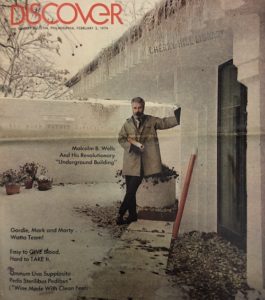
Malcolm B Wells And His Revolutionary “Underground Building” [Photo courtesy of Cherry Hill Library]
Architect Daniel R. Nichols of the Ragan Design Group, will speak about the life and work of iconoclastic architect Malcolm Wells, the architect of the “old” Moorestown Township Municipal complex — the one that was “new” in the 1970s — and the subject of the Historical Society’s new exhibit that opens at Smith-Cadbury this fall.
Wells championed environmentally responsible design and was considered the father of earth-sheltered architecture, that is, buildings at least partially underground. He advocated for what he called gentle architecture. In the world of what we would call today a “green building,” Wells is considered a seminal and inspirational figure. Besides the old Municipal Complex he designed several other structures in Moorestown, including residential dwellings, office buildings and the Methodist Church.
Dan Nichols is a member of the Cherry Hill Historic Commission and an architect dedicated to the preservation of historic buildings. He also worked on our new Municipal Center.
This program is part of the New Jersey History Speaks lecture series.
To register click here.
The following events have already occurred.
David Boulden: Facts and Artifacts
Tuesday September 19th, 7pm
Moorestown Library
“Facts and Artifacts”, a compelling program about but not limited to the British retreat in this area during the revolution, begins the new season of the Historical Society of Moorestown’s History Speaks Lecture Series on Tuesday, September 19th at
7:00 p.m. at the Moorestown Library. Local historian and independent researcher David Boulden discusses in great detail his and others findings about the British retreat through New Jersey from Philadelphia in 1778.
Inspired by a presentation he heard at the Mount Laurel Historical Society in February, 2020, Mr. Boulden embarked on the fascinating adventure of a lifetime. Suspicious of some of the widely held beliefs about the British retreat, he put his mind and muscle to delving deeper into long held theories. He did not confine his research to books, museums and libraries, however. With a goal of confirming or challenging the conventional wisdom about the retreat, Boulden instead used a hand-held metal detector across Camden County and Burlington County, following the trail believed to have been taken by the British. From August, 2020 to April, 2022 he walked thousands of miles, dug countless holes, spent over 1700 hours in the field and collected over 2,500 pounds of items. And he lost 35 pounds in the process! David will discuss his findings and what they tell us about this important time in the history of South Jersey.
The presentation is free and open to the public. To register click here.
A Still Important 1686 NJ Provincial Path, the Keith Line
with Bruce Blair and Joe Grabus
Wednesday May 10, 7pm
Moorestown Library
Folks around here often mention South and North Jersey, even Central, like they’re different states. In fact it was “East” and “West” that became separate proprietary provinces in 1674 after Britain had taken New Netherland from the Dutch. The British divided the land in half and gave control to Sir George Carteret ( East) and Lord John Berkeley (West). With no thought of indigenous peoples, European immigrants, comprised mainly of Quakers, settled in the West facing the Delaware and Philadelphia; in the East facing the Raritan and Hudson Rivers and New York City were Reformed Protestants by and large. But property and practice disputes rose from the original deed of division and a better boundary had to be formalized.
In 1686 George Keith was Surveyor-General when he ran the first survey to mark the separation. He and his small crew, combining astonishing skill with steadfast endurance, in just 5 harrowing weeks lay the 60 mile line, traipsing through marshes, crawling through thickets, uphill and down, using only a crude transit, compass and intricate chain. It was a grueling feat. And yet all their work soon was for naught as the separation only lasted until 1702 when the Jerseys were united as New Jersey. Master surveyors Bruce Blair and Joe Grabus of Central New Jersey will tell the stories to give credence to this tale and why it matters today from Province Line Road in Mercer and Somerset Counties to sports to TV to taxes. Giants or Eagles?
To register click here.
Sponsored by the Elizabeth Tuttle Foundation.
The following events have already occurred.
The Quaker Scout: Testimony of a Civil War Non-Combatant of the Woodlawn Anti-Slavery Colony with Martha Claire Catlin
Wednesday April 12th, 7pm
Moorestown Library

In 2010, Martha Claire Catlin, historian for the Alexandria, Virginia Quaker Meeting at Woodlawn, retired from a career in historic preservation at the federal Advisory Council on Historic Preservation. Building on 30 years of research, her current emphasis is on the Woodlawn settlements of antislavery Quakers, many of whom were from Moorestown. Their story is now featured in the Historical Society of Moorestown’s exhibit “Inscribed Quilts: A Portal to Moorestown History.”
Her most recent book “The Quaker Scout: Testimony of a Civil War Non-Combatant of the Woodlawn Anti-Slavery Colony,”is the story of Jonathan Roberts who was a member of the Woodlawn Colony. The Quakers of Woodlawn, well-educated progressive agriculturalists from northern states, were successful in establishing a colony of free-labor farms, uneasily surrounded by George Washington’s Mount Vernon heirs and others of the slaveholding planter elite. Among the new freeholders of the colony were African Americans descended from Mount Vernon’s enslaved population, manumitted by Washington at his death a half-century earlier. The Friends converted thousands of acres of plantation lands into productive free-labor farms, hoping their example would become a transformative influence throughout the South. Yet, with increasing sectionalism in the years leading up to war, even the faithful could see that the possibility of ending slavery by peaceful means – however strategically devised, and diligently practiced – was diminishing. It was this realization that sent Roberts on his amazing adventure.
This presentation is the perfect companion piece to the Historical Society’s current exhibit.
This lecture is preceded by a short Historical Society Annual Meeting.
To register for this event click here.
Sponsored by the Elizabeth Tuttle Foundation.
The following events have already occurred.
Ten Crucial Days of the American Revolution with Geoff Gamble
Wednesday March 8th, 7pm
Moorestown Library
Geoff Gamble, author and Judge Advocate for the New Jersey Society of Cincinnati will speak on the “Ten Crucial Days of the American Revolution”. Gamble will explore the critical days from December 25, 1776 through January 3, 1777 often referred to as the “Ten Crucial Days” of the War of Independence. It was during this period that George Washington, some would say for the first time, demonstrated his leadership abilities with decisiveness and persistence, just as the American cause was on the verge of collapse. The events of these ten days restored confidence and spirit on the American side, which ultimately led to victory.
To register for this event, click here.
Sponsored by the Elizabeth Tuttle Foundation.
The following events have already occurred.
Roebling: Company Town, 1905-1947 Immigrants, Moonshine and Crap Tables with Louis Borbi
Wednesday January 25th, 7pm
Moorestown Library
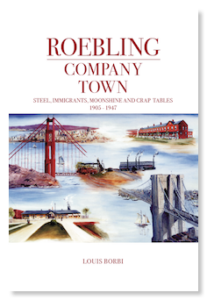
Join author Louis Borbi, one of the founding members of the Roebling Historical Society, as he speaks about his book Roebling: Company Town, 1905-1947 Immigrants, Moonshine and Crap Tables. It is the story of the unique community of Roebling, New Jersey, built by John A. Roebling and Sons Company for their workers at the steel plant they located along the Delaware River, some eleven miles south of Trenton.
To attend this program, click here to register.
This program is part of the Historical Society of Moorestown’s New Jersey History Speaks Lecture Series.
Sponsored by the Elizabeth Tuttle Foundation.
The following events have already occurred.
Quilt presentation back by popular demand!
For those who missed the lecture event on “Inscribed Quilts: A Portal to Moorestown History” by Historical Society expert Linda Vizi a few weeks ago, you’re in luck! She will deliver her presentation again next Tuesday November 22 at 10:00 a.m. in the meeting room at the Moorestown Public Library. All are welcome. To register, click here.
After the event, have lunch on Main Street and drop by the Smith-Cadbury Mansion when it opens at 1:00 on Tuesday to see the new quilt exhibit. Our gift shop will also be open for early holiday shopping.
A window into the history of Moorestown is opened through a sample of signature ( inscribed) quilts from the mid 1800’s. Each signature tells an incredible story of a group of Moorestown residents who were courageous, inventive and daring. Their strength and perseverance helped to shape Burlington County and other parts of the very young United States of America. The exhibit paints a vivid picture of life in Moorestown during the mid 1850’s: our farms, businesses, homes and families. They illustrate the hard work, determination, devotion and foresight of our residents.
After Linda’s presentation, members of the Mid-Atlantic Quilt Study Group will be invited to share their inscribed quilts.
The following events have already occurred.
Lafayette at Brandywine: The Making of an American Hero
Thursday November 10th, 7pm
Moorestown Library
Author Bruce E. Mowday will speak about his latest book Lafayette at Brandywine: The Making of an American Hero. 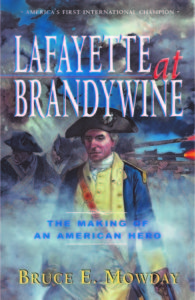 “America’s first international hero, the Marquis Lafayette, risked his life and spent his fortune in the fight for American independence from England. Without Lafayette and the assistance of France, America would never have been victorious during the American Revolution. While being celebrated in America in the 18th and 19th century – including a grand American tour that lasted more than a year – Lafayette’s heroic deeds are fading from America’s consciousness. The importance of the battle of Brandywine, where Lafayette was wounded on September 11, 1777, has not been recognized as a major turning point in America’s independence. Lafayette at Brandywine: The Making of an American Hero redefines Lafayette’s role in America’s fight for freedom and the historical importance of the battle of Brandywine.”
“America’s first international hero, the Marquis Lafayette, risked his life and spent his fortune in the fight for American independence from England. Without Lafayette and the assistance of France, America would never have been victorious during the American Revolution. While being celebrated in America in the 18th and 19th century – including a grand American tour that lasted more than a year – Lafayette’s heroic deeds are fading from America’s consciousness. The importance of the battle of Brandywine, where Lafayette was wounded on September 11, 1777, has not been recognized as a major turning point in America’s independence. Lafayette at Brandywine: The Making of an American Hero redefines Lafayette’s role in America’s fight for freedom and the historical importance of the battle of Brandywine.”
This topic has relevance with the discovery, by Trustee Gary Ell, of a letter written by William Blodgett, from Moorestown, to General Weeden in November of 1777 which reads:
“I am directed by General Greene to request that, he has received intelligence of General Glover’s brigade who will be be within a few miles of this place tonight as he had ordered the Troops to be in motion by eight o’clock tomorrow morning, wishes you to be here with the Marquis, if not too much fatigued tonight. Should the Marquis be fatigued the General thinks he had best join in the morning”.
The particular concern for Lafayette was due to the fact that he had not fully recovered from a serious wound he had suffered in the Battle of Brandywine on September 11, 1777. The eyewitness to Lafayette’s visit, cited in the Purdy book, reported that he was not well.
A copy of the William Blodgett letter will be on display.
Registration is required. Click here to register.
Sponsored by the Elizabeth Tuttle Foundation.
The following events have already occurred.
Inscribed Quilts: A Portal to Moorestown History
Wednesday October 12th, 7pm
Moorestown Library
A window into the history of Moorestown is opened through a sample of signature (inscribed) quilts from the mid 1800’s. Each signature tells an incredible story of a group of Moorestown residents who were courageous, inventive and daring. Their strength and perseverance helped to shape Burlington County and other parts of the very young United States of America. Their stories will be told in the new exhibit: The Inscribed Quilts: A Portal to Moorestown History opening this fall at Smith-Cadbury Mansion, 12 High Street, Moorestown, NJ. The exhibit will paint a vivid picture of life in Moorestown during the mid 1850’s: our farms, businesses, homes and families. They will illustrate the hard work, determination, devotion and foresight of our residents.
Historical Society Trustee, Linda Vizi, who is the curator of the new exhibit will give an overview of the exhibit, the steps she took to research the stories of the quilt signers, and share a few of her favorites.
A very brief business meeting will precede Ms. Vizi’s presentation.
To register click here.
This program is part of the Historical Society of Moorestown’s New Jersey History Speaks Lecture Series.
Sponsored by the Elizabeth Tuttle Foundation.
The following events have already occurred.
Alice Paul and the History of the Equal Rights Amendment
Wednesday April 6th, 7pm
Virtual via Zoom
Join Quincy Wansel from the Alice Paul Institute as she presents a program about Alice Paul and the history of the Equal Rights Amendment:
The Alice Paul Institute, located in Mt. Laurel, began in 1985 as the Alice Paul Centennial Foundation to commemorate the 100th anniversary of the author of the Equal Rights Amendment’s birth. Eventually the organization was given the opportunity to purchase her childhood home “Paulsdale” saving the house and property from development. Today, as the Alice Paul Institute, the organization continues to educate and empower girls and young women to view themselves as leaders, encourage civic engagement, preserve Paulsdale and advocate for the Equal Rights Amendment.
The Historical Society has partnered with Moorestown Library to bring you this virtual lecture. The New Jersey History Speaks lecture series is free and open to the public.
Tonight’s talk will be preceded by a brief Historical Society business meeting. All are welcome!
Registration is required.
To register via the Library’s website, click here.
To find out more about the Alice Paul Institute click here.
Sponsored by the Elizabeth Tuttle Foundation
The following events have already occurred.
Garden State Gangland with Scott M. Deitche
November 10th, 7pm
Virtual via Zoom
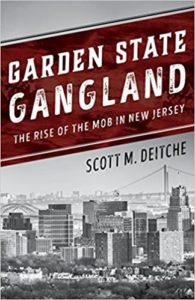
Author and organized crime expert Scott M. Deitche joins us to talk about his book Garden State Gangland. Deitche begins with the early turn of the century Black Hand gangs and unravels the mob’s growth through the 20th century. He looks at how influential the mob was, not only to goings-on in the Garden State but across the New York metro region and the country as a whole.
The New Jersey History Speaks lecture series is free and open to the public.
This lecture is scheduled to be held virtually via Zoom.
Click here to register.
Sponsored by the Elizabeth Tuttle Foundation
The following events have already occurred.
Annual Meeting & the kickoff of the new season of the NJ History Speaks Lecture Series!
When Women Lost the Vote: A Museum of the American Revolution Presentation
Matt Skic, curator at Museum of the American Revolution
October 6th, 7pm
Virtual via Zoom
Millions of American women were granted the right to vote with the ratification of the 19th Amendment in 1920. But did you know that more than a century earlier, women legally held the right to vote in New Jersey? In a groundbreaking exhibition, the Museum of the American Revolution explored the little-known history of the nation’s first women voters — and examined the political conflicts that led to their voting rights being stripped away in 1807. Join us when we host one of the Museum’s researchers, Moorestown resident Matt Skic, and get an inside look at the Museum’s exhibition, When Women Lost the Vote: A Revolutionary Story, 1776-1807. Learn the little-known history of the nation’s first women voters including women who lived in and around Moorestown. Get a virtual peek at artifacts that tell their stories and bring to life the women who laid the foundation for the suffragists two generations later.
All lectures that are part of the New Jersey History Speaks series are free and open to the general public — either in person or virtually.
This lecture is scheduled to be held virtually via Zoom.
Click here to register.
To view the virtual exhibit at the Museum of the American Revolution, click here.
Sponsored by the Elizabeth Tuttle Fund
Hello HSM Members and Friends,
When comedians have new material they want to test out, they often make quiet cameo appearances at small comedy clubs to see how their new material plays in front of a live audience. For example, one night I was in a no frills Los Angeles comedy club expecting to see a few no name comics tell some lame jokes. Instead, Jay Leno popped on stage to explain that he had Tonight Show material he wanted to test out. Some of the jokes were funny; some were duds. That week, a few of the funny jokes were in his opening monologues.
With that premise in mind, I am giving a lecture this month which will be part of a lecture series hosted at a nearby university. I would like to do a test run of this lecture with a small audience before I do it for the larger audience later this month. If you are interested in attending this trial run, please feel free to join me Monday, April 19th at 7:30pm. A description of the lecture and the Zoom information for joining is below.
Hope you can attend!
Mickey DiCamillo
Addressing the Toxic Work Environment: The Creation of the Haskell Laboratory for Toxicology and Industrial Medicine.
April 19th, 7:30pm via Zoom
In the years following the American Industrial Revolution, little attention was paid to worker safety. Permanent injury and death were too often outcomes in American mines and factories, and many companies made little effort to improve working conditions. Then, in 1932 twelve people working in a DuPont dye manufacturing plant in Deepwater, New Jersey were diagnosed with similar forms of cancer.
The DuPont company, working for over a century with explosive black powder, knew the importance of safety in the workplace. It had long been a leader in workplace safety and was one of the first companies to create an internal medical division to advise on employee safety. Now it needed to rethink its strategy with the company’s future staked in chemical production and its employees becoming alarmingly ill. This lecture will use newly released archival material to explore the circumstances that led to the creation of the Haskell Laboratory For Toxicology—a pioneering laboratory that studied the hazards of the many new chemicals going into production during the 20th century. The lecture introduces the men and women at Haskell that helped create the field of toxicology research, and it explains how the laboratory maintained its credibility despite being a department within one of the world’s largest chemical producing companies.
Join via Zoom
https://us02web.zoom.us/j/89279716431?pwd=eFNQc3BMS3h2YTZaMlZrUWxJKzRTdz09
Meeting ID: 892 7971 6431
Passcode: 945594
Spring Meeting & Book Talk
Wednesday April 7th, 7pm via Zoom
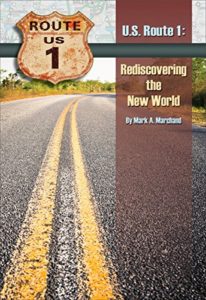
After a brief business meeting, speaker Mark Marchand will discuss his book, U.S. Route 1: Rediscovering the New World, about his experience driving the entire length of U.S. Route 1 from Northern Maine through New Jersey and Pennsylvania and finishing in Key West.
“In late-June 2014, I set out from my home in upstate New York to drive the entire length of U.S. Route 1 from remote, forested northern Maine to artsy, bucolic Key West. As it snakes along the East Coast for over 2,400 miles, this famous — but somewhat ignored — highway winds through some of our nation’s most complex, congested cities before passing through the wide-open expanses of the Carolinas and down into Florida.
Along the way, the super-fast I-95 beckoned me with its lure of no traffic lights and three lanes. But I ignored its siren call.
It was an eye-opening experience. From the fascinating people I met to the sites I visited, I was left with an indelible image of what used to be known as the New World to Europeans and others who first began landing here centuries ago. From the crafty ticket scalper at the Baltimore Orioles’ Camden Yards ballpark to the Baptist minister in Aiken County South Carolina, the people I met along the way were the America I sought to see through the lens of this over 80-year-road.”
Join the Zoom meeting with the information below:
https://us02web.zoom.us/j/82103438657?pwd=d2RUUGdLNXVJSU1KYXU0MHZrV0lGQT09
Meeting ID: 821 0343 8657
Passcode: 513689
In partnership with the Moorestown Library, Historical Society President, Mickey DiCamillo, kicks off the virtual return of the New Jersey History Speaks Lecture Series with his talk titled, Jersey Tales: Quirky Stories About New Jersey’s History. Have you heard the one about the submarine buried in the Rancocas Creek? Or, the one about Jewish mobsters brawling with Nazis in Newark? Did someone ever tell you that a Frank Lloyd Wright designed home stands in Cherry Hill, or a railroad for bicycles once enabled South Jersey commuters to peddle their way to work? Hear a collection of tales about New Jersey’s past and the people keeping these memories alive.
This Zoom presentation will take place October 14, 2020 from 7:00 to 8:00 pm on your computer or device. This is an online event and you must register at the following link: https://moorestownlibrary.libcal.com/event/7149432 to be admitted. The event URL will be sent via registration email.
or call the Library at 856-234-0333
This event is free and open to the public.
A message from our President:
Hello Everyone,
As you might expect, we are temporarily shuttering the Historical Society of Moorestown due to the current efforts to curb the spread of COVID-19. This means that our annual meeting scheduled for April 8th at the Moorestown Public Library has been postponed. We will work with the library to reschedule, but everything is simply on hold at this time.
Further, we are closing the Smith-Cadbury mansion for the foreseeable future.
We plan to re-evaluate on April 9th whether to continue the closure or reopen the mansion for archives access and tours.
I do hope that you all are doing ok during this stormy time of anxiety and concern. Remember, for all of the big talk about “unprecedented” action and “extreme” measures, none of the actions thus far (closing schools, churches, bars/restaurants, curfews) are truly without precedent. All of these measures were taken in Camden in 1918 during the flu epidemic. Unfortunately, in 1918 these measures were taken too late. Let’s hope that our preemptive strike has a positive effect, and we say goodbye to coronavirus just in time to say hello to seasonal allergies!
Take Care,
Mickey DiCamillo, president
Historical Society of Moorestown
Wednesday April 8, 7pm at Moorestown Public Library
Jersey Tales: Quirky Stories About New Jersey’s History
with Mickey DiCamillo
THIS EVENT HAS BEEN POSTPONED.
Have you heard the one about the submarine buried in the Rancocas Creek? Or, the one about Jewish mobsters brawling with Nazis in Newark? Did someone ever tell you that a Frank Lloyd Wright designed home stands in Cherry Hill, or a railroad for bicycles once enabled South Jersey commuters to peddle their way to work? Historical Society president Mickey DiCamillo cobbles together a few short stories about New Jersey’s past and highlights the people and institutions keeping these memories alive.
The New Jersey History Speaks Lecture Series is collaborative program between the Historical Society of Moorestown and the Moorestown Public Library. All lectures are held at the Moorestown Public Library, and they are free and open to the public. Space is limited; please reserve your seat in advance by calling the library at 856-234-0333 or click here to register online.
Wednesday May 20, 7pm at Moorestown Public Library
The Convention: Birthing the United States Constitution in 1787
with Stuart Leibiger, Professor of History at LaSalle University
The United States Constitution is the world’s oldest written national constitution still in use. Rather than a triumph of one faction’s ideas and beliefs, the Constitution developed in a messy, contentious convention where a multitude of fears and staunchly held beliefs collided. Stuart Leibiger, author of the recent book The Constitutional Convention of 1787: A Reference Guide, has combed through the primary sources documenting the lead-up to the convention, the day-to-day happenings at the convention, and the final ratification of the document. His narrative tells how this convention gave birth to such an enduring document as well as New Jersey’s role in this historic achievement.
The following events have already occurred.
Wednesday March 11, 7pm at Moorestown Public Library
The history of The Blue Comet, the “Seashore’s Finest Train” with Hank Cutler and Randy Acorcey
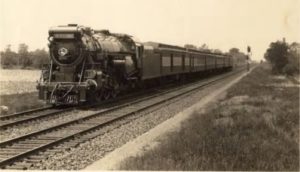
On March 11th @ 7pm, the New Jersey History Speaks Lecture Series welcomes back Hank Cutler and Randy Acorcey to speak again on New Jersey’s railroad history. This time they will present a program that explores the history of The Blue Comet, the “Seashore’s Finest Train.” The Blue Comet served passengers of the Central Railroad of NJ from 1929 to 1941. Billed as a first class train at coach fares, the Blue Comet broke all standards of railroading in 1929 ferrying passengers between Jersey City and Atlantic City. Unfortunately, the train didn’t always enjoy a smooth ride. Hank and Randy recently hiked extensively in an area where the Blue Comet crashed, and they have cleared up some misconceptions on the actual location of the crash through both reports and pictures. Join us to learn more about this special train and its unique history. 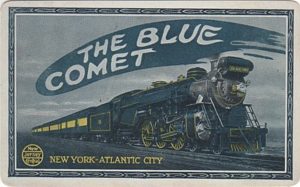
The New Jersey History Speaks Lecture Series is collaborative program between the Historical Society of Moorestown and the Moorestown Public Library. All lectures are held at the Moorestown Public Library, and they are free and open to the public. Space is limited; please reserve your seat in advance by calling the library at 856-234-0333 or click here to register online.
Wednesday January 8th, 7pm at Moorestown Public Library
The King’s Highway – An Award Winning Documentary Film with filmmaker Jason Sherman
Every day that you walk or drive on Moorestown’s Main Street you connect with a past that stretches across 1300 miles and three centuries. Main Street aka King’s Highway was carved out in the 1700’s and connected Boston to Charleston (as well as places in between such as Philadelphia, Moorestown, Haddonfield, and Swedesboro). The NJ History Speaks Lecture Series returns to the Moorestown Library on January 8th and welcomes filmmaker Jason Sherman who will screen his film The King’s Highway and partake in a Q&A after the film. The King’s Highway discusses the critical colonial and revolutionary era events that occurred along the old road. While Sherman’s film focuses particularly on the portion of the road that runs through Northeast Philadelphia, the film’s themes of historical preservation and the need to understand the past will resonate through all neighborhoods along the highway’s stretch. Voted Best Documentary Feature at the FirstGlance Film Festival and previously aired as a special feature on PBS, The King’s Highway is a must see!
The NJ History Speaks Lecture Series is a joint effort between the Historical Society of Moorestown and the Moorestown Library. All events in the series are free and open to the public. The King’s Highway screening begins at 7pm and has a runtime of 1 hour and 30 minutes. The Q&A follows immediately after.
To register please click here.
The following events have already occurred.
Wednesday, November 6th, 7pm at Moorestown Public Library
Surviving the American Revolution with Aaron Sullivan, Ph.D.
Today, we remember the American Revolution as a glorious cause that gave birth to a new form of freedom, but how did people in New Jersey, Philadelphia, and the surrounding region feel about a war that erupted in their own backyard in 1778?
Historian Aaron Sullivan explores the British occupation of Philadelphia during the War for Independence, chronicling the experiences of a group of people who were pursued, pressured, and at times persecuted, not because they chose the wrong side of the Revolution but because they tried not to choose a side at all. For these people, the war was neither a glorious cause to be won nor an unnatural rebellion to be suppressed, but a dangerous and costly calamity to be navigated with care.
Aaron Sullivan is an historian and author living near Philadelphia. He holds a Doctorate in History from Temple University and a Bachelor’s Degree in Computer Science from Letourneau University. Sullivan’s new book, The Disaffected: Britain’s Occupation of Philadelphia During the American Revolution, explores the plight of those who chose not to pick a side in America’s war for independence and was published by the University of Pennsylvania Press in March.
Registration is requested. To register click here or call the Library at 856-234-0333
Sponsored by the Elizabeth Tuttle Fund.
The following events have already occurred.
Wednesday, October 2, 7pm at Moorestown Public Library
The Jersey Shore: The Past, Present, and Future of a National Treasure with Dominick Mazzagetti
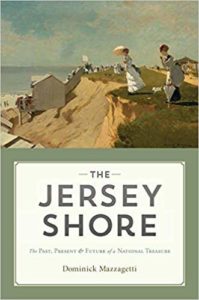 The New Jersey History Speaks Lecture Series Returns for Season 5! Dominick Mazzagetti kicks off the new season and tells of the history, culture, and landscapes of the Jersey Shore from the 1600s to the present. What did the beach look like to Native Americans and early explorers? What industries thrived along the coastline before amusement rides and carnival games? What factors propelled the region into a national tourist destination in the eighteenth century? And, what does the future hold for this fragile but critically important ecological and economic treasure? Mr. Mazzagetti brings a scholar’s depth along with a local’s enthusiasm to the place of eternal summer. To read more about tonight’s speaker click here. This evening’s program will include a few minutes for the Historical Society’s Fall General Meeting which is open to the public.
The New Jersey History Speaks Lecture Series Returns for Season 5! Dominick Mazzagetti kicks off the new season and tells of the history, culture, and landscapes of the Jersey Shore from the 1600s to the present. What did the beach look like to Native Americans and early explorers? What industries thrived along the coastline before amusement rides and carnival games? What factors propelled the region into a national tourist destination in the eighteenth century? And, what does the future hold for this fragile but critically important ecological and economic treasure? Mr. Mazzagetti brings a scholar’s depth along with a local’s enthusiasm to the place of eternal summer. To read more about tonight’s speaker click here. This evening’s program will include a few minutes for the Historical Society’s Fall General Meeting which is open to the public.
Registration is requested. To register click here or call the Library at 856-234-0333. Registered guests will receive seating first. Guests who are not registered will receive any remaining seats. See you there!
Wednesday, May 8th, 7pm at Moorestown Public Library
Close to Shore with Pulitzer Prize nominee Michael Capuzzo
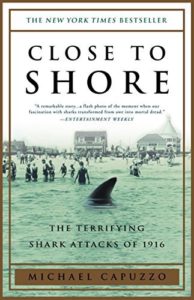
Here’s a New Jersey first you weren’t expecting: the first U.S. shark attack on swimmers happened at the Jersey Shore. The summer of 1916 at Jersey beach towns was no “day at the beach.” In July of that year, a lone Great White left its usual deep-ocean habitat and terrorized the New Jersey shoreline for weeks. With blood in the water, scientists stressed over how to stop a vicious, unpredictable predator before any more people in the area perished. Pulitzer Prize nominee, and author of the New York Times Best Seller Close to Shore Michael Capuzzo is coming to Moorestown to tell this tale of the historical Jaws. Before you go to the shore this Memorial Day Weekend, be sure to hear this gripping story. This is the final installment of the 2018-2019 New Jersey History Speaks Lecture Series, a cooperative effort of the Historical Society of Moorestown & the Moorestown Library.
About the Author
Michael Capuzzo is the author of the critically acclaimed New York Times nonfiction bestsellers Close to Shore and The Murder Room. He is a former staff writer for the The Philadelphia Inquirer and The Miami Herald, and has written for Sports Illustrated, Esquire, The Wall Street Journal and The Washington Post. He has been nominated six times for the Pulitzer Prize for his books and newspaper stories, twice for the National Book Award.
Close to Shore, a nonfiction historical thriller about the 1916 New Jersey shark attacks that inspired the book and movie JAWS, was a People magazine Top Ten book of the year, called an “adventure classic” by The New Yorker, was excerpted in Reader’s Digest, and was read aloud for one week on BBC Radio in London. The book was recently optioned by SONY Pictures Television for a proposed mini-series.
The Murder Room, the true story of “the living Sherlock Holmes,” Richard Walter, and the Vidocq Society of Philadelphia, is “a gripping page turner, masterfully drawn and full of truth, dedication and darkness,” said Michael Connelly, the bestselling detective novelist, and “shows once again that Capuzzo is one of our most brilliant writers.” The book was the subject of an our-long ABC 20/20 special program, and is in the Hollywood script-writing stage now for a proposed weekly series.
Mike graduated from Northwestern University in Evanston, IL with a degree in journalism and philosophy, and from Goucher College in Baltimore with an MFA in Nonfiction writing. He has appeared on the Today Show, CBS News, CNN, Fox News, the O’Reilly Factor, NPR’s All Things Considered, Talk of the Nation, and Fresh Air. He and his wife Teresa Banik Capuzzo, a former Philadelphia Inquirer staffer and formerly restaurant critic for Philadelphia Magazine, live in Teresa’s hometown of Wellsboro, PA, where they founded and publish Mountain Home, an award-winning regional magazine with 100,000 readers in upstate Pennsylvania and New York.
Registration is requested. Registered guests will receive seating first. Guests who are not registered will receive any remaining seats.
To register click here. Or, call the Library to register at 856-234-0333.
This event is sponsored by the Elizabeth Tuttle Foundation.
The following events have already occurred.
This talk, originally scheduled for February 20th, was postponed due to inclement weather. We’re glad Gordon Bond can join us at our upcoming Spring Annual Meeting!
Wednesday, April 10th, 7pm at Moorestown Public Library
The Wreck of the Broker: The Story of New Jersey’s Deadliest Train Wreck
SPEAKER: Gordon Bond, Independent scholar, historian, and author
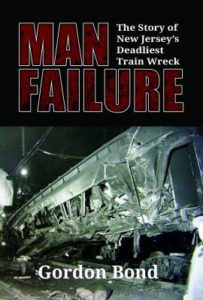
On the drizzly evening of February 6, 1951, the Pennsylvania Railroad commuter train known as “The Broker” derailed in Woodbridge, New Jersey, killing 85 and injuring hundreds in what remains the deadliest railroad accident in the state’s history and among the top five in the United States. Gordon Bond authored the definitive book on this tragedy, and he uses eyewitness accounts, news reports, and investigation transcripts to recount the disaster and explore its impact.
Registration is requested. Registered guests will receive seating first. Guests who are not registered will receive any remaining seats.
To register click here. Or, call the Library to register at 856-234-0333.
This event is sponsored by the Elizabeth Tuttle Foundation.
The following events have already occurred.
Wednesday, March 13th, 7pm at Moorestown Public Library
American Women and Royal Marriages: New Jersey’s Real-Life “Lady Coras”
SPEAKER: Melissa Ziobro, Assistant Professor of History | Monmouth University
Season One of Downton Abbey begins in 1912, but a key element of the show’s story line occurred decades earlier, off screen, when a wealthy young American heiress named Cora Levinson of Cincinnati met and married Robert Crawley, Viscount Downton, the future Earl of Grantham. As part of their marriage contract, Cora’s fortune would be tied to the Grantham family’s failing estate to prevent it from going bankrupt. In return, Cora would eventually earn the title of Countess of Grantham. While Downton Abbey’s Granthams are fictional, wealthy American heiresses marrying impoverished European nobility is not. There were hundreds of these marriages, including several featuring brides with roots in New Jersey.
Registration is requested. Registered guests will receive seating first. Guests who are not registered will receive any remaining seats.
Please call the Library to register at 856-234-0333 or click here to register online.
This event is sponsored by the Elizabeth Tuttle Foundation.
***
This talk has been postponed due to inclement weather.
Wednesday, February 20th at Moorestown Public Library
The Wreck of the Broker: The Story of New Jersey’s Deadliest Train Wreck
SPEAKER: Gordon Bond, Independent scholar, historian, and author

On the drizzly evening of February 6, 1951, the Pennsylvania Railroad commuter train known as “The Broker” derailed in Woodbridge, New Jersey, killing 85 and injuring hundreds in what remains the deadliest railroad accident in the state’s history and among the top five in the United States. Gordon Bond authored the definitive book on this tragedy, and he uses eyewitness accounts, news reports, and investigation transcripts to recount the disaster and explore its impact.
Registration is requested. Registered guests will receive seating first. Guests who are not registered will receive any remaining seats.
Please call the Library to register at 856-234-0333 or click here to register online.
This event is sponsored by the Elizabeth Tuttle Foundation.
The following events have already occurred.
Wednesday, January 16th at Moorestown Public Library
Ellis H. Parker: “Sherlock Holmes of America” & Burlington County’s First Chief of Detectives
SPEAKER: Marisa Bozarth, Burlington County Museums
In early 1906, Florence Allison of Moorestown was murdered at a home she created for homeless children. To identify the killers and bring them to justice, the county relied upon Ellis H. Parker, Burlington County’s first Chief of Detectives. Parker was known across the country as the “Sherlock Holmes of America” and he resolved the Allison case as well as approximately 300 other major crimes from local New Jersey murders to cases that perplexed Scotland Yard. Then, Parker took on the “crime of the century” — the Lindbergh baby kidnapping — and his life was changed forever. Marisa Bozarth, museum curator for Burlington County, takes us through the life and times of a man who for most of the early 20th century was not only Burlington County’s #1 detective but also a sleuth revered around the world.
Registration is requested. Registered guests will receive seating first. Guests who are not registered will receive any remaining seats.
Please call the Library to register at 856-234-0333 or click here to register online.
This event is sponsored by the Elizabeth Tuttle Foundation.
Wednesday, November 14th, 7pm
Christopher Andrew Maier as Eldridge Reeves Johnson
Just for the Record: The Life of Eldridge Reeves Johnson
The New Jersey History Speaks Lecture Series continues season 4 tonight!
Longtime Moorestown resident and benefactor, Eldridge Reeves Johnson founded the Victor Talking Machine Company in Camden, New Jersey in 1901. At home in Moorestown, Johnson donated funds to build the Moorestown Community House and lived comfortably for twenty-five years in Breidenhart Castle (today Lutheran Crossings) where he passed away in 1945.
Join us when Christopher Andrew Maier brings Eldridge Johnson back to life and back to Moorestown in this multimedia one-man show including music, slides, blueprints and a demonstration of both a Victor Talking Machine and an Edison Phonograph!
Registration is requested. Registered guests will receive seating first. Guests who are not registered will receive any remaining seats.
Please call the Library to register at 856-234-0333 or click here to register online.
This event is sponsored by the Elizabeth Tuttle Foundation.
The following events have already occurred.
Special Three-Part Series: The Salem Witch Trials
The Salem Witch Trials are one of the most iconic events in United States history. However, the events surrounding the trials and the motivations of the participants remain habitually misunderstood. Join us this October under a darkened, autumn sky, in a garden lit by lantern light, for a three-part mini series on the trials. We will unravel the events of 1692, analyze archival documents from the period, and reveal the continued relevance of the trials more than 300 years after the final accused witch hanged on Gallows Hill. Moorestown Historical Society president Mickey DiCamillo hosts this three-evening event that includes audience participation in a 1692 witch trial!
Part 1: The Salem Witch Trials – The Usual Suspects
Wednesday, October 10th @ 7:30pm in the Smith-Cadbury Garden
Part 2: The Salem Witch Trials – Strangely Accused
Wednesday, October 17th @ 7:30 pm in the Smith-Cadbury Garden
Part 3: The Salem Witch Trials – A Conspiracy of Witches
Wednesday, October 24th @ 7:30 pm in the Smith-Cadbury Garden
Reserve your seat for all three nights for $15.00. E-mail Mickey DiCamillo at mdicam@hotmail.com for ticket information.
Only 30 seats available, so get your tickets today!
(Note: Single night tickets are not available.)
Monday, October 8th, 7pm
Michael DiCamillo
In Flew Enza – The 1918 Flu Epidemic in New Jersey and Philadelphia
The Historical Society of Moorestown is pleased to announce its Fall General Meeting to be held at the Moorestown Public Library on Monday October 8th, at 7:00 p.m.
Exactly 100 years ago, one of the most devastating flu epidemics in U. S. History arrived on the heels of one of the deadliest wars. Mickey DiCamillo, president of the Historical Society of Moorestown and research librarian at Jefferson University, will explain where scientists believe the disease originated (likely not in Spain as popularly believed), how this epidemic spiraled out of control, and how health officials and citizens responded to the disease’s horrors. From Philadelphia to Camden… Haddonfield to Newark… no community escaped the influenza epidemic of 1918.
*Rite-Aid Pharmacy will offer flu shots at the meeting starting at 6:30pm!*
There will be a questionnaire for those who are interested. Insurance info will be requested but the shot will be free.
Please note, the time on the Main St. banner is incorrect. The meeting begins at 7:00 but those desiring a flu shot should come at 6:30.
This event is free and open to the public. Registration is requested. Registered guests will receive seating first. Guests who are not registered will receive any remaining seats.
Please call the Library to register at 856-234-0333 or click here to register online.
This event is sponsored by the Elizabeth Tuttle Foundation.
The following events have already occurred.
The Historical Society presents the Summer Speaker Series in the Smith-Cadbury Garden
Join us on the Smith-Cadbury patio for iced tea, lemonade, and other summer treats. Then, deepen your understanding of New Jersey’s role in World War 1 with an outdoor twilight talk from one of our area’s experts.
July 11th, 7:30pm
In Flew Enza: The 1918 Flu Epidemic in Philadelphia & New Jersey
One of the most devastating flu epidemics in U.S. history came on the heels of one of the deadliest wars. Mickey DiCamillo, president of the Historical Society of Moorestown and processing archivist at the Historical Society of Pennsylvania, will explain how this epidemic spiraled out of control and how people in this region reacted to its horrors.
August 8th, 7:00pm
“Jungle of Weeds” to War: Fort Monmouth and World War I
The United States had a very short time to prepare itself for World War I, and one symbol of that rapid preparation was Fort Monmouth which went from a “jungle of weeds” to war readiness in a matter of months. Melissa Ziobro, Professor of Public History at Monmouth University and the last Command Historian at Fort Monmouth before its closure, will explain the role Fort Monmouth played in advancing U.S. communications and technology during World War I. She will also touch upon some of the other military bases in New Jersey that were in service during the war.
**Please Note: Admission is $5 and tickets must be purchased in advance. Seating is limited, so purchase your tickets today! To RSVP, please email Mickey DiCamillo at mdicam@hotmail.com
Tickets may be purchased through PayPal below.
The following events have already occurred.
The Rise and Fall of Baseball’s Negro Leagues
Jonathan Mercantini
Wednesday, May 9th @ 7pm
Most of us know that Jackie Robinson broke the color barrier in Major League Baseball’s National League when Robinson made his debut for the Brooklyn Dodgers on April 15th, 1947. But, it was Larry Doby, an African-American ballplayer from a Negro Leagues ball club in New Jersey that broke the color barrier in MLB’s American League. Join us on May 9th when Kean University professor Jonathan Mercantini presents The Rise and Fall of Baseball’s Negro Leagues and traces the origins of segregated baseball, the development and growth of the Negro Leagues, and their eventual demise in the wake of MLB integration. Intertwined in his lecture is the story of the Newark Eagles, a Negro Leagues team that featured future Hall-of-Famer Doby as well as an enterprising baseball executive named Effa Manley who became the first female to be inducted into the Baseball Hall of Fame.
Please call the Library to register at 856-234-0333 or click here to register online.
This lecture in the New Jersey History Speaks Series is funded by the Elizabeth Tuttle Foundation.
A review of New Jersey’s First Photographers a talk given by Gary D. Saretzky on Wednesday, April 4th
On April 4, in front of a sizeable crowd at the Moorestown Library, photography historian Gary D. Saretzky held forth on 19th century New Jersey photographers – in particular, those plying their trade in Burlington County. His softly spoken remarks and dry humor were amply illustrated by a generous selection of early photographs which he incorporated into an engrossing Power Point presentation for a thorough look at early photography technology and the local camera-wielders who used it.
Of course, Mr. Saretzky took us to photography’s 1830s beginnings, with the advent of the daguerreotype, the production of which was a complicated but revolutionary process named after the French inventor, Louis Daguerre. The daguerreotypist would expose a silver-plated copper sheet to vapor emitted by iodine crystals. This would produce silver iodide. When subjected to light and inserted into the camera, the sheet with silver iodide would capture an image. This process was expensive, painstaking and time-consuming. The chemical compounds were toxic. Mr. Saretzky said that these pictures were produced in different sizes and used in jewelry or to decorate the heads of canes.
Things got exciting in New Jersey, when, in 1839, NJ inventor Seth Boyden, Jr., began creating dageurreotypes. But things became even more exciting when one Joseph Dixon of Jersey City, inventor of the Dixon lead pencil, contributed to the evolution of the next phase of photography, the collodion process. In this process, explained Mr. Saretzky, light-sensitive glass plates would capture the image. Prints could be made on special photographic paper containing albumen, from egg whites, for the tintype variation of the collodion process. Mr. Saretzky said that the reason that albumen prints nowadays look like they have age spots on them is because people tended to handle the prints indiscriminately, leaving behind skin oils and fingerprints that, over time, reacted with the egg whites to show up as unattractive spots.
Mr. Saretzky said that albumen prints could be mounted on cardboard and sent through the mail, as well as made into different sizes – from the small carte-de-visite to the cabinet cards and stereographs. The latter were produced as a pair of pictures that, when glimpsed through a viewer, made a 3-D image. Mr. Saretzky noted that people often had baskets of these stereographs at home in the parlor, for ready viewing.
From here, Mr. Saretzky focused exclusively on Burlington County photographers of the 1800s. He said that NJ, which was largely rural at the time, had fewer photographers than some other states. There were 149 NJ photographers in 1870; the figure swelled to 700 by 1900. In Burlington County alone, there were 100 photographers between 1842 and 1900. He said that some photos were made in Stanwick, which is now a section of Moorestown, but most were made in Bordentown, Burlington and Mount Holly.
Besides the Stanwick connection, Moorestown’s own J. Stogdell Stokes was elected a member of the Photographic Society of Philadelphia in 1898.
Because of the modest earnings of most photographers, they often had remunerative sidelines. Benjamin F. Lee, who was first a daguerreotypist in Vincentown and later a photographer in Mount Holly, also sold hats and caps, and was, variously, the Burlington County Sheriff, a lay judge in the Court of Common Pleas, and a cashier at Mount Holly National Bank. He died in Mount Holly in 1901.
Thomas Baker of Burlington was a watch-maker, and also served as an alderman and a justice of the peace. Baker’s sometime photography partner, Burlington’s George W. Tichenor, was also a fisherman, a naturalist, and a “South Jersey Weather Prophet.” Tichenor took pictures until the end of his life; in 1911, he was photographing a picture of an ambulance when he died suddenly. 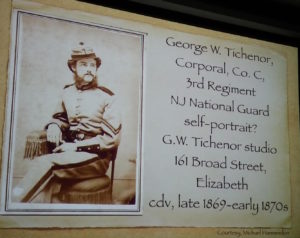
L. T. Kinch, of the Kinch Brothers photography concern in Bordentown, was also variously a firefighter, assistant paymaster for the railroad, an Odd Fellow, and a baseball player! Unfortunately, he was killed in an 1867 shooting incident. Peter Walker took pictures in Mount Holly. He became famous for photographing the brain of a murder victim and testifying at the accused’s criminal trial. His life took a downward spiral, however. He went from sought-after photography expert to crime victim to defendant: he was mugged on the Bispham Street Bridge in Mount Holly, jailed for wife beating, and later jailed again for stealing a harness. After all of that drama, Walker died of appendicitis while on the operating table.
Lastly, Mr. Saretzky told us about two notable women photographers of Burlington County. There was Henrietta Wardle of Riverton, who took pictures for H. D. Garns & Co. in Philadelphia and Camden and died in 1909 of stomach cancer. Then there was Bertha M. Lothrop, daughter of Philadelphia photographer David Lothrop.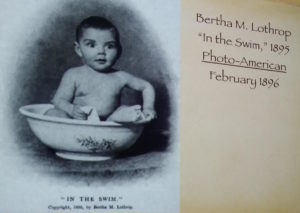 By 1896, she and her father had built a photography studio in the backyard of their Riverton home. She eventually married a widower named Frederick Radell; some of her later pictures were thus credited to “Bertha Radell.” She specialized in child photography and published multiple papers and articles on the subject. Eventually, she settled in Abington Township, Pennsylvania, where she died in 1932.
By 1896, she and her father had built a photography studio in the backyard of their Riverton home. She eventually married a widower named Frederick Radell; some of her later pictures were thus credited to “Bertha Radell.” She specialized in child photography and published multiple papers and articles on the subject. Eventually, she settled in Abington Township, Pennsylvania, where she died in 1932.
Thanks to Gary D. Saretzky for a most illuminating talk, and to the Moorestown Library for co-hosting it!
– Liz Rosenthal
The following events have already occurred.
New Jersey’s First Photographers
Gary D. Saretzky
Wednesday, April 4th @ 7pm
During photography’s infancy in the 19th century, approximately 3,000 different photographers were active in New Jersey. Quite a few lived or worked in Burlington County including such pioneers as Thomas Baker and George W. Tichenor. Join us on April 4th when archivist and photographer, Gary D. Saretzky introduces us to the early days of photography and how people in New Jersey experienced and experimented with a medium that changed American society.
This talk will be preceded by brief updates on the business and activities of the Historical Society.
All NJ History Speaks lectures are free and open to the general public. If you plan to attend, please register with the Moorestown Public Library at (856) 234-0333 or online at their event calendar.
This program has been made possible in part by the National Endowment for the Humanities (NEH) and the New Jersey Council for the Humanities (NJCH). Any views, findings, conclusions, or recommendations expressed in this program do not necessarily represent those of the NEH or NJCH.
Cancer Alley or The Garden State?
Presented by Thomas Belton, Research Associate in Science Writing with the Philadelphia Academy of Natural Sciences of Drexel University
Wednesday, March 14th @ 7 pm
Through the lens of human interest stories and environmental events, Thomas Belton will discuss the environmental history of New Jersey with a particular focus on significant ecological events that affected South Jersey. Mr. Belton will explain how land use from 400 years ago still impacts our land and health today. Additionally, he will discuss how progressive thinkers in the 1970s prompted a closer look at protection, preservation, and stewardship, which resulted in protective legislative policies. Finally, he will discuss how citizens can be informed and empowered to act on critical issues that still affect our environment. Thomas Belton is an author, journalist, environmental scientist and a marine biologist. He has published short stories in Cicada and Art Times, feature articles in the New York Times and Philadelphia Inquirer as well as numerous magazines. Having worked for the New Jersey Department of Environmental Protection for 25 years as a research scientist, Tom is currently a Research Associate in Science Writing with the Philadelphia Academy of Natural Sciences of Drexel University.
Space is limited, so please register in advance here: https://events.r20.constantcontact.com/register/eventReg?oeidk=a07ef48cq3d2b144655&oseq=&c=&ch=
or by calling the Library Reference Desk at 856-234-0333. Anyone not registered will receive seating based on available space.
This program has been made possible in part by the National Endowment for the Humanities (NEH) and the New Jersey Council for the Humanities (NJCH). Any views, findings, conclusions, or recommendations expressed in this program do not necessarily represent those of the NEH or NJCH.
Beyond Shipwrecks: Exploring a Sunken Locomotive off the New Jersey Coast
On February 21, 2018 at the Moorestown Library, Dan Lieb held his listeners rapt, just as he had in November 2016. Before, it was shipwrecks off the NJ coast. Now it was the exploration of two small, mid-19th century locomotives mysteriously sitting on the ocean floor off Long Branch NJ. 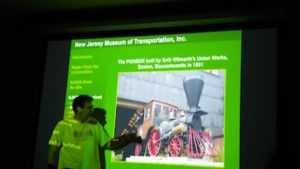
Lieb, president of the New Jersey Historical Divers Association, said that an associate of his, Paul Hepler, captain of the Venture III, first noticed a large object submerged off Long Branch around 1984. It was rediscovered by the National Oceanic and Atmospheric Administration in a 1991 survey, and re-rediscovered in the 2000s by the NJ Historical Divers Association. (In 2004, this discovery was featured on the History Channel.) After several dives off Captain Hepler’s boat in the early 2000s, Lieb said that they could finally identify the large mass – two diminutive train engines, without passenger cars. But how old were these locomotives? Had they ever been used? By whom? And how did they settle under 85 feet of sea water?
The engines, one of which had fallen to pieces, provided several clues that might help to answer some of those questions. For example, both locomotives were of the rare, “2-2-2” configuration, meaning that they had two small, forward wheels, ahead of two large wheels, ahead of two more small wheels that, all together, sort of looked like this: oOo. But the locomotives themselves were so small that 10 of them could have fit into the Moorestown Library room where Lieb was speaking!
These locomotives, powered by steam, contained an important clue as to the purpose of the engines. The tallow cup, which lubricated the steam engine with refined animal fat, was especially small, about the size of a tea cup, Lieb explained. Thus, the train would have had to make numerous stops, typical of a commuter train, to refill the tiny tallow cup. But, said Lieb, many of the engine components were unique in design, meaning that these trains were likely built before the railroad industry had settled on train component patterns. The New Jersey Museum of Transportation found that the saltwater-marinated locomotives had been built between 1851 and 1854 and most resembled the well-known Pioneer locomotive, which evoked the storybook image of the train with its impressive smokestack and the protruding, grate-like cowcatcher at the front. Only eight locomotives of the 2-2-2 configuration were ever made, and two of them have been underwater for well over 150 years!
Dan Lieb said that small locomotives like these would have been transported over water by schooner. Probably the two discovered off Long Branch were never used but, in a mishap, fell into the water, still brand-new, from a schooner.
Lieb and his associates faced a delicate challenge – how to secure salvage rights so that they could eventually rescue the trains from the saltwater. They had to go to court to apply for an “admiralty arrest”; if a rightful owner didn’t come forward, then the application would be granted. Once Lieb, et al., won the application, they had to figure out how to attach the admiralty arrest papers to the engines.
Next came planning on how to bring the locomotives or pieces thereof to the surface. Lieb and the others are still gathering data in preparation for raising, conserving, and interpreting these 19th century artifacts. Perhaps Lieb will return in the not-too-distant future to update us on their efforts!
The Historical Society of Moorestown and the Moorestown Library would like to thank Dan Lieb for another successful NJ History Speaks event.
-Liz Rosenthal
Riding the Rails in Moorestown with Hank Cutler
About 80 people attended “Riding the Rails in Moorestown,” a January 17 talk at the Moorestown Library given by Hank Cutler and Randy Arcorcey, two local railroad experts. The event, co-sponsored by the Historical Society, took us on a nearly 200-year railroad journey that wound its way through Moorestown to and from the Philadelphia and New York areas. Said Acorcey, “You don’t know where you are until you know where you came from.”
The steam engine had an early start right in our backyard when New Jersey entrepreneur, Robert Stevens, the founder and first president in 1830 of the Camden and Amboy Railroad, imported the so-called John Bull Locomotive for use here. Initially, Acorcey told us, locomotives such as the John Bull ran on tracks constructed with “stone sleepers,” which led to an uneven surface and accidents. Eventually, the much more stable railroad ties became the norm. Robert Stevens, who was also an inventor, facilitated this transition by creating the hook-headed spike, which kept the ties in place. Stevens also invented the railroad baggage car.
By the late 1860s, said Acorcey, the Camden and Amboy stretched over 22 miles from Camden to Pemberton. Moorestown had at least two stations along the way. The first station was on the east end of Moorestown at Chester Avenue and East Third Street. Eventually, Moorestown acquired a second station at North Church Street and West Central Avenue, which became known as the Stanwick station. Acorcey mentioned that there is some controversy as to whether Moorestown also had two other stations, Wilson and Lenola. This “Pemberton Branch” of the railway, which cut through Moorestown, lasted 100 years, from 1868 to 1968!
Hank Cutler focused his portion of the presentation on “sidings,” or the direct connections railroads had with local businesses. In Moorestown, the enterprises with railroad sidings changed over time. They included C. A. Lippincott & Bro., at Third and Union streets, which dealt in lead, zinc, putty, glass, and paints, among other things; and J. S. Collins & Son, at Mill Street, which specialized in lumber and coal.
Romano’s Service Station on Chester Avenue sits on the former site of the East Moorestown railway station; a dental practice occupies the old station building. Hollingshead Fuel, which used to be at East Third & Chestnut, had a siding. It dated back to the late 19th century and only closed in 1992! Other Moorestown companies with sidings included Yerkes Canning Company, at Schooley Street. At Zelley Avenue and Pearl Street, companies with sidings included Rogers Terra Cotta Company. The site is now a baseball diamond in Fullerton Memorial Park.
A big thank-you for a successful evening is due Randy Acorcey and Hank Cutler, as well as the event’s co-sponsor, the Moorestown Library.
-Liz Rosenthal
February 21st at 7pm: Beyond Shipwrecks: Exploring a Sunken Locomotive off the New Jersey Coast
New Jersey’s Underwater explorer Dan Lieb returns to Moorestown to discuss a mysterious find resting under the rough Atlantic water: a sunken locomotive. How did a train end up buried under the Atlantic? How long has it been there? What sort of treasures have been found onboard? Lieb explores these questions and more as he takes us underwater once again to learn about the things buried along the Jersey Coast.
Space is limited, so please register in advance using the link below or by calling the Library Reference Desk at 856-234-0333. Anyone not registered will receive seating based on available space.
https://events.r20.constantcontact.com/register/eventReg?oeidk=a07eewu2pk6d4fdad19&oseq=&c=&ch=
Come learn history with us!
January 17th at 7pm: Riding the Rails in Moorestown with Hank Cutler.
Some of the nation’s first railroads were built right here in South Jersey, including tracks that ran through Moorestown. In a talk sponsored by the Historical Society of Moorestown in conjunction with the Moorestown Library, railroad historian Dr. Hank Cutler will share Moorestown railroad history and tell the stories behind current and former railroad landmarks in town. Many may already know Dr. Cutler from his dental practice in nearby Haddonfield.
***The registration limit for this talk has been met. Anyone not registered will receive seating based on available space. We apologize for the confusion regarding registration.
Our Fall General Meeting is open to the public!
Thursday October 5th, 7:30pm at the Moorestown Community House. Our speaker will be Richard J. Connors, Ph.D author of the new book, New Jersey and the Great War: 1914-1919(Dorrance Publishing, 2017). Dr. Connors will discuss New Jersey’s role in World War I and the war’s impact locally, nationally, and internationally. He will also explain how the war influenced world events that followed.
“With this insightful analysis, Richard J. Connors, Ph.D. commemorates the contribution of the State of New Jersey and its citizens on the centennial anniversary of World War I. Because of its coastal location and much-needed industry, New Jersey played a significant role both prior to and during America’s declared involvement. Historical detail brings to life pre-war America and the daily lives of those who would sacrifice so much. From immigration to industry and infrastructure, we see the factors that contributed to the war effort. Well before America’s formal entry to the war, supplies and volunteers to European forces shaped public perception and involvement and laid the groundwork. Once war was declared, the bulk of New Jersey’s National Guard units, draftees, and volunteers served in two US Army Divisions, the 29th and the 78th; their roles in particular are meticulously researched. New Jersey and the Great War offers a fresh look at the background and aftermath of the state uniquely poised in its preparation for world-wide war.” (New Jersey and the Great War: 1914-1919)
Dr. Connors received his undergraduate degree at Seton Hall and his graduate degrees from Columbia University. Major works include: The Process of Constitutional Revision in New Jersey, 1940-1947, The Government of New Jersey (written with William Dunham), and The New Jersey Constitution of 1776. Dr. Connors has contributed articles to The Encyclopedia of New Jersey, The Governors of New Jersey, and The Dictionary of American Biography, among other publications. An Army veteran, in 1947 Dr. Connors was an officer in the U.S. Army Corps of Engineers with the Army of Occupation on Okinawa. He also served in Korea from 1951-1952. He currently resides in Neptune City, New Jersey.
Our meeting is free and open to the public. Refreshments will be served. Please join us!
The following events have already occurred.
The Ragged Road to Abolition, Slavery and Freedom in New Jersey, 1775-1865
The final lecture in this season’s New Jersey History Speaks series took place the evening of May 10th at the Moorestown Public Library. University of Arkansas professor Dr. James Gigantino joined us live via Skype to explain why New Jersey was the last northern state to end slavery. He pointed out that New Jersey, as a northern state with a large Quaker population, is commonly believed to have been a proponent of abolition in the years up to and including the Civil War. In actuality, New Jersey initially rejected the 13th Amendment to the Constitution to abolish slavery and only accepted it after it had been ratified by 3⁄4 of the state legislatures after the end of the Civil War. With the Mason-Dixon line passing through the southern part, New Jersey was really a border state.
Early on, the Revolutionary War gave rise to anti-abolition sentiment in New Jersey. Many slaves escaped to join the British (and also rebel) forces. As many slaves embraced the revolution’s message of freedom, New Jersey agricultural landowners lost a key labor force. As the Revolutionary cause prevailed, the land and slaves of loyalists to the crown were confiscated by the state. Instead of freeing those many slaves, the state chose to sell them and benefit from that revenue. After the war, although slavery declined in the more Quaker segment of West Jersey, it grew exponentially in the more populous East Jersey which relied heavily on slave labor for agriculture (especially the growing of corn, wheat and pigs), mining, timber harvesting and salt production. In 1804, New Jersey passed a statute for the gradual abolition of slavery that did little to further the cause. African American children born after July 4, 1804 were freed but had to serve their mothers’ masters for a period of 21 years for women and 25 years for men as “apprentices” or “slaves for a term.” Slaves born before 1804, saw no benefit until 1846 when they were then considered freed but still “apprentices for life.”
Dr. Gigantino made it clear that abolition in New Jersey was a complicated affair. Remembering what it was like to be slave holders, a kind of “historical amnesia” led many New Jersey politicians to align themselves with the south on the question of fugitive slaves. Extremist anti-Civil War movements like the Copperheads had a strong foothold in the state. Abraham Lincoln lost the popular vote in New Jersey in both 1860 and 1864. Thankfully the spirit of Lincoln and the concept of abolition prevailed.
Professor Gigantino is the author of The Ragged Road to Abolition: Slavery and Freedom in New Jersey, 1775-1865, a book published by University of Pennsylvania Press. If you missed the lecture, copies of the book are available in the gift shop of the Smith-Cadbury Mansion.
— Stephanie Herz
The following events have already occurred.
Upcoming: Wednesday May 10th, 7pm at the Moorestown Library
The Ragged Road to Abolition, Slavery and Freedom in New Jersey, 1775-1865
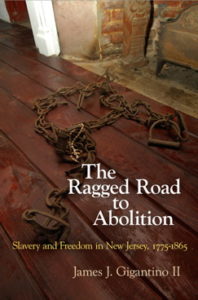
As part of its ongoing NJ History Speaker Series, The Historical Society of Moorestown in conjunction with the Moorestown Library presents Professor Jim Gigantino II (via SKYPE!) who will discuss his book “The Ragged Road to Abolition: Slavery and Freedom in NJ 1775-1865.”
Despite what many Americans may think, the issue of slavery in the Antebellum Period was not neatly divided along the Mason-Dixon line. Professor Gigantino will trace New Jersey’s efforts to abolish slavery within the state – a plodding process that turned the notion of “free state” on its head and allowed slavery to persist in New Jersey until the end of the Civil War. Event attendees will gain a deeper understanding of the political complexities of the Civil War and the role New Jersey played.
Professor Jim Gigantino II is the Associate Chair and Director of Graduate Studies in the Department of History at the J. William Fulbright College of Arts & Sciences, University of Arkansas. He is an Early American historian who specializes in the history of slavery and was awarded the 2015 Robert P. McCormick Prize by the New Jersey Historical Commission and the 2015 New Jersey Studies Academic Alliance Authors Award for his book, The Ragged Road to Abolition, Slavery and Freedom in New Jersey, 1775-1865.
Read about the book here.
Review of Our Annual Meeting with speaker Martin Kane, April 6th, 2017:
The Annual Meeting of the Historical Society of Moorestown at the Community House this past April 6 was an important one. Not only did the presidential baton pass from outgoing president Leonard Wagner to incoming president Michael DiCamillo, but the Indian Springs Questers presented HSM with a generous check for $1,525.00. And it just so happened that the date of the meeting fell on the 100th anniversary of America’s entry into World War One. So who better to give the night’s presentation than Martin Kane, an expert on the accomplishments of New Jerseyan Hudson Maxim, armaments inventor and promoter of the need for America’s military “preparedness”?
This Hudson Maxim, a native of Maine, was quite a character. His lifespan took him from 1853, in a time of growing unrest over slavery, to 1927, a time defined by jazz, Prohibition, and a bullish stock market. He took strong, public positions on issues of the day – a women’s suffragist, he opposed smoking and Prohibition. He also had a variety of passions and wrote on many topics. He loved to cook, especially baked beans, and came up with his own spaghetti recipe. He published a book called Real Pen Work about proper penmanship, as well as a volume called, The Science of Poetry. Maxim considered himself a poet, too, writing “Lincoln: A Man of the People,” a piece that was read at the 1922 dedication of the Lincoln Memorial in Washington DC. He recognized early on that airplanes had potential for use in war and became one of the first presidents of the Airplane Society in New York City.
While Maxim initially settled in Brooklyn, he eventually made his way to Lake Hopatcong in northwestern New Jersey, a popular resort served by two railroads. Here he spent the rest of his life. His brother, Hiram, an American expatriate, got him interested in inventing tools of war, including explosives and propellants. As the speaker, Martin Kane, pointed out, Hudson Maxim’s armaments inventions did have peaceful uses, but their military applications were much more profitable. His invention of smokeless gunpowder was helpful in northern New Jersey mining, but its use in war generated the most income. He could be a victim of his own inventiveness, accidentally blowing his left hand off in 1894.
Maxim was best known for his book, Defenseless America, published during World War One, in which he argued that America was completely unprepared for military aggression. He believed that New York City was susceptible to being bombarded into submission, which would then lead to all of America falling to the aggressor. A movie, Battle Cry of Peace, was based on his book. All of this worry led to the creation of a Naval Advisory Board, on which Hudson served, along with such notables as Thomas Edison and Secretary of the Navy Josephus Daniels (whose immediate subordinate was a future president, Franklin D. Roosevelt). Maxim became so important that he hobnobbed with not only former President Teddy Roosevelt, but also 1920s presidents Harding and Coolidge.
In case anyone is wondering, Maxim did have a Moorestown connection – his son lived here for 50 years!
Martin Kane, a personable speaker, brought Hudson Maxim to life for his listeners. Mr. Kane is proud of his work modernizing and expanding the Lake Hopatcong Historical Museum, and has also been involved with the awarding of scholarships at his alma mater, Seward Park High School. In the past, he was an attorney and manager at Picatinny Arsenal in the New Jersey Highlands.
In observance of the World War One milestone, after the History Rocks! exhibit ends in June, HSM will work on a new exhibit exploring Moorestown’s role in the war.
-Liz Rosenthal
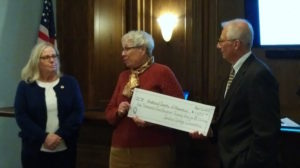
Jeanne Alper and Gail Greenberg from the Indian Springs Questers present Lenny Wagner with a very generous donation!
Learning About Our New Jersey Ancestors Through Land Records
a talk given by Joseph Grabas, March 15th, 2017
If you want to do genealogical research or learn more about how people once lived their lives, go check out New Jersey land records. They’re not just about who owned which parcel of land. As speaker Joseph Grabas, a leading expert in historical land title research, told a fascinated audience at the Moorestown Library on March 15, you can find out about everything from familial discord to debtor/creditor arrangements to what society disapproved of in New Jersey’s past.
Mr. Grabas, the author of Owning New Jersey: Historic Tales of War, Property Disputes,and the Pursuit of Happiness (The History Press, 2014), is an engaging speaker. He said that, typically, research will tell you how a seller acquired his land, with the chain of title going all the way back to the beginning. But there are surprises – lots of them. He described a land record that included the will of a farmer named John Robinson who had four sons. All the sons but one received money or practical items. Poor Timothy got “good, stout rope to hang his Irish wife.”
In land records, you can discover the sorts of land transactions people engaged in centuries ago, back to colonial times – with deeds, mortgages, easements, other land use restrictions, and federal liens showing up at one time or another. Land use restrictions might address whether a property owner could use his home to run a business (hence, the term “cottage industry”). Besides federal liens there were all sorts of other liens that a researcher might run across – construction, doctor/hospital, institutional, even one based on an illegitimate birth. On the latter point, a lien might have been placed on a landowner’s property to provide for the upbringing of a child produced out of wedlock. Records include burial plot deeds, building contracts, and, during a shameful period in New Jersey history, slave manumissions.
Mr. Grabas told of property owners whose presumably private issues could become public. He found deeds referring to a “lunatic” and a “spinster.” More pleasant are descriptions of a home’s inventory. Want to know if a family grew fruits on their property? If they had a “cider press,” they probably maintained an orchard. Want to know if they liked to entertain? Chairs for 30 people suggested they did.
The speaker is one of only 25 people in New Jersey designated a Certified Title Professional and one of the first five people in the US designated a National Title Professional by the American Land Title Association. He has searched, examined and/or insured over 100,000 land titles in five States and all 21 NJ counties over the last 40 years. Among other things, Mr. Grabas has pioneered the field of interpretive land records research, and is a State Court expert in land title and real estate matters.
This presentation was sponsored by the Historical Society of Moorestown in conjunction with the Moorestown Library.
-Liz Rosenthal
The following events have already occurred.
Up next:
The Annual Meeting of the Historical Society of Moorestown will feature a presentation at the Community House, 16 East Main St., Moorestown NJ 08057 on Thursday, April 6 at 7:30 p.m., by Martin Kane, historian, author, and president of the Lake Hopatcong Historical Museum.
On this date, the 100th anniversary of America’s entry into World War One, Mr. Kane will speak about Hudson Maxim, a New Jersey innovator who held a patent for smokeless gunpowder, invented a variety of high explosives, and designed a torpedo-proof ship. The inventor advocated for a national armaments movement prior to U.S. entry into WWI, and was an early and ardent supporter of women’s rights.
The speaker, Martin Kane, is proud of his work modernizing and expanding the Lake Hopatcong Historical Museum. Mr. Kane has also been involved with the awarding of scholarships at his alma mater, Seward Park High School. In the past, he was an attorney and manager at Picatinny Arsenal in the New Jersey Highlands.
This event is free and open to everyone!

The next talk in our Speaker Series, Land Deeds and the Illumination of State, Local, and Family History, will be given by Joseph Grabas author of Owning New Jersey: Historic Tales of War, Property Disputes, and the Pursuit of Happiness. Mr. Grabas will discuss how people of different backgrounds fought to claim their piece of the Garden State. He also will share the bizarre and mysterious stories that emerge from NJ’s property records. Finally, he will discuss how property records can reveal a great deal about family history and are an excellent source for genealogists. This event, which will take place on March 15th at the Moorestown Library, is free and open to the public. Please join us!
The following event has already occurred.
New Jersey’s Multiple Municipal Madness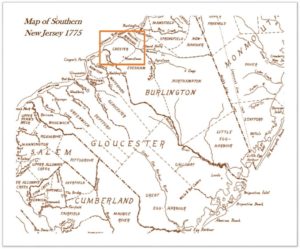
New Jersey’s residents historically have been of the bickering sort, said Michael DiCamillo, Vice President of the Historical Society of Moorestown, at his talk, “New Jersey’s Multiple Municipal Madness,” which drew a large audience on January 18, 2017 at the Moorestown Library. Because of this contentiousness, New Jersey is divided into 566 municipalities, many more than exist in California – our nation’s most populous state – which has only 482.
How did people’s divisiveness lead to the creation of so many little towns, both big and small? Michael DiCamillo explained all of this in a brilliant review of the sometimes petty, sometimes economically-based, sometimes racially- or class-charged disputes that led to the splintered New Jersey residential landscape we know today. His talk was based on his own research, as well as on the 1998 book, New Jersey’s Multiple Municipal Madness, written by the late Alan Karcher, a former Speaker of the New Jersey State Assembly.
Mr. DiCamillo said that there are five reasons for New Jersey’s prodigious promulgation of localities. They are: street fights (disagreements about the need for streets and street maintenance), the rise of railroad towns, the creation of school district boroughs, the formation of dry versus wet towns, and the secession of exclusive enclaves of people.
Disagreements over streets and street lighting pitted rural areas of New Jersey against population centers. Haddonfield resulted from one such dispute, when it separated itself from Haddon Township. Other towns sprang up with the burgeoning building of railroads. Collingswood was founded in 1888 by Edward Collings Knight, who bought up properties around railroad depots and marketed them to people who wanted to live outside Philadelphia but still work there.
Of particular interest to Moorestown residents would be the break-up of Chester Township due to the incursion of railroads into South Jersey, with Moorestown, surrounded by farmland, being an important population center. Chester, founded in 1688, eventually split into Cinnaminson, Delran, Riverside, Riverton, Palmyra, Moorestown, and Maple Shade.
An 1894 New Jersey law required towns to consolidate their schools into one municipal district. Previously, residents of different neighborhoods in the same town were responsible for maintaining only the schools to which they sent their children. People wanting to avoid the consolidation of schools into one district, because of, for example, their aversion to newly-arrived European immigrants, created separate towns.
Religious beliefs often led to the creation of new towns. The “camp meeting” movement, active especially in some Jersey Shore towns (like Belmar and Avon-by-the-Sea), led to dry versus wet localities and the enactment of blue laws. The alienation of working families from more religious residents who enacted strict laws affecting secular behavior led to further secessions. The tiny town of Tavistock was formed in 1921 by a handful of people who, during the height of prohibition, wanted to be able to play golf and (secretly) drink.
Other people desired exclusive enclaves where they could be rid of vagrants, especially in the wake of the Panic of 1873 when unemployment skyrocketed and the jobless moved from place to place looking for work.
This talk was sponsored by the Historical Society in conjunction with the Moorestown Library. Michael DiCamillo, the speaker, has taught history at LaSalle University and served as a reference and research librarian at the University of Pennsylvania.
-Liz Rosenthal
The following event has already occurred:
Our next event is January 18th at 7pm at the Moorestown Library when Vice-President of the Historical Society, Michael DiCamillo, will discuss New Jersey’s Multiple Municipal Madness, a book written by Alan Karcher, a former Speaker of the New Jersey General Assembly.
New Jersey has 566 municipalities. In contrast, California has 482. Why does New Jersey have so many independent towns and subsequently so many municipal governments? Michael DiCamillo, who has taught history at LaSalle University and has served as reference and research librarian at the University of Pennsylvania, will discuss Alan Karcher’s book which details how and why New Jersey divided itself … then divided itself again … and again to accommodate a variety of differences among New Jersey neighbors. Included in the discussion will be the case of Chester Township which was sliced and diced to form Riverside, Riverton, Palmyra, Delran, Maple Shade, Cinnaminson, and Moorestown. Historic maps will be on display to help everyone visualize the boundaries that currently and formerly divided the state.
Please join us at the Moorestown Library, Meeting Room A, on January 18th at 7 pm for this talk.
The following events have already occurred.
Dan Lieb, president of the New Jersey Historical Divers Association, gave an animated, nail-bitingly suspenseful talk about shipwrecks of New Jersey on November 16, 2016 at the Moorestown Library. The Library joined the Historical Society of Moorestown in cosponsoring the event. Well over 80 people attended, and it was standing-room-only in the back with more people spilling out of the doorway leading into Meeting Room A.
Over the fascinating two hours, which included Mr. Lieb’s illustrated presentation plus a generous question-and-answer session, we learned that there are about 7,200 New Jersey shipwrecks which have been found off the Atlantic coast and Delaware Bay, as well as in other NJ waterways. He told us stories about some of the more tragic wrecks and the circumstances causing them. In 1846, The John Mintern ran aground off Squan Beach in a bad storm that, in total, sank 10 vessels, with dozens of lives lost. Especially terrible was the loss of the New Era in 1854 which had sailed from Germany. About 50 people died of cholera on the way over, with another roughly 295 people losing their lives when the ship struck the Jersey Shore at Deal Beach in a Nor’easter. During the two world wars, the enemy was a lot closer than most people know – many U.S. ships were sunk off the coast by German U-boats! Mr. Lieb said that, sometimes, when he and his fellow divers discover another old shipwreck, they are only able to identify it by comparing evidence from the wreck with historical records. If just bits and pieces of a wreck turn up, they may have to contact collectors of items found in wrecks to help with identifying it. Thanks to Dan Lieb and the Moorestown Library for making this event such a huge success!
-Liz Rosenthal
The following events have already occurred.
The second season of our New Jersey History Speaks speaker series begins this month!

Dive Sites & Shipwrecks
New Jersey Scuba Diving
Dan Lieb, president of the New Jersey Historical Divers Association presents: Shipwrecks off the New Jersey Coast on Wednesday, November 16th, 7pm at the Moorestown Library in Meeting Room A
What lies underneath the dark Atlantic waters that rush along the New Jersey coast? Dan Lieb, president of the New Jersey Historical Divers Association, has dived deep into these cold, rough waters and has discovered amazing shipwrecks that reveal New Jersey’s significant history. From wrecked luxury liners to sunken German U-Boats, Mr. Lieb–who has appeared on History Channel’s Deep Sea Detectives–will describe what lies buried in New Jersey’s ocean floor and will share the tales of courage, terror, and survival that accompany the wrecked vessels.
All speaker series events are free and open to the public thanks to a generous grant from the Elizabeth Tuttle Fund and a cooperative effort with the Moorestown Library.
Advanced registration is not required but it is requested. Click the link to the registration page:
http://www.huntcal.com/cal/eventview/moorestownlibrary/moorestownlibrary?vm=r&yr=2016&id=477599004&d=16&m=11
Other upcoming talks in the New Jersey History Speaks lecture series will trace natural and manmade boundaries to understand why New Jersey has more municipalities than California, and delve into the Garden State’s property records for some personal family histories and the struggles some people have endured to own a piece of New Jersey land. More information about these talks will be provided in the near future. You may contact Michael DiCamillo of the Historical Society of Moorestown at mdicam@hotmail.com if you have any questions about the lecture series.
The following events have already occurred.
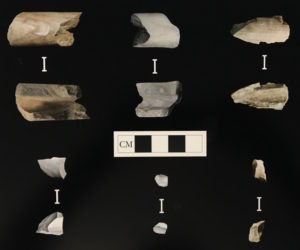
Tubular stone pipe fragments found at the Madeira site in Moorestown.
The Historical Society’s Fall General Meeting at the Moorestown Community House, Thursday October 13th at 7:30 pm
In anticipation of our new exhibit, History Rocks: Interpreting the Archaeological Discoveries in Moorestown, Dr. Gregory D. Lattanzi, Curator for the Bureau of Archaeology & Ethnology and New Jersey State Archaeologist at the New Jersey State Museum in Trenton, will speak about the archaeology of New Jersey and will highlight some important sites and new insights at our General Meeting, which is open to the public, on October 13th at 7:30 pm at the Moorestown Community House. Please join us!
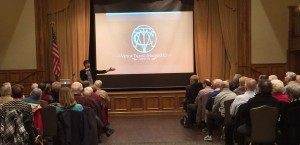
Graham Alexander at the Moorestown Community House
Graham Alexander, April 7th at Moorestown Community House
Graham Alexander, a local singer-songwriter with experience on Broadway, was the featured speaker before dozens of people at the Annual Meeting of the Historical Society of Moorestown held on April 7 at the Moorestown Community House. Though only 26, Alexander, through a combination of financial savings, luck, and pluck, has managed to acquire the Victor Talking Machine Company and its associated record labels, all of which had lain dormant for decades until just a few years ago, and which were operated in the City of Camden by Victor founder and Moorestown resident Eldridge Johnson. Those labels include some very familiar names: Victor, Victrola, Camden, His Master’s Voice, Little Nipper, and Electrola. Alexander is in the process of reviving the labels and, in doing so, not only releasing his music and the music of other promising acts, but releasing or re-releasing as many as he is able to of the 10,000 master recordings he has managed to track down. Among the legendary singers and musicians who at one time or another recorded for one or more of the Victor labels were Enrico Caruso, Nat King Cole, Billie Holliday, Perry Como, Louis Armstrong, Fats Waller, Dinah Shore, Jimmie Rodgers, Rachmaninoff, Leonard Bernstein, and Duke Ellington. Victor founder Johnson was an involved member of the Moorestown community, providing major funding for the Community House, and supporting Moorestown’s activities in other ways. Moorestown residents have probably seen the numerous statues of the iconic Little Nipper dog situated about the town which serve to commemorate Johnson’s impact.
-Elizabeth J. Rosenthal
Read more about Graham Alexander at his website: http://www.graham-alexander.net/#latest
and about Victor Records: http://www.victorrecords.com/
Graham Alexander to speak at our Annual Meeting April 7th, 7:30pm at the Community House
Remembering and Reviving South Jersey’s Connection to the Music Biz
Special Guest Speaker: Graham Alexander—singer, songwriter, musician, actor, and owner of the Victrola, His Master’s Voice, and Victor Talking Machine Co. labels, and Little Nipper!
In the early decades of the 20th Century, the Victor Talking Machine Company and Victor Records were among the most prominent companies in the music and electronics industries. Its Camden headquarters helped the city thrive, and the company’s founder, Eldridge Johnson, made his home here in Moorestown. (Johnson lived on Main Street in the home that today is the Lutheran Home.) Johnson’s legacy in Moorestown is palpable. He donated large sums of money to support the town’s activities, and in 1923 he donated $250,000 for the purpose of constructing the Moorestown Community House. Since the Little Nipper dog was the iconic symbol of Johnson’s iconic company, Moorestown has commemorated Johnson’s legacy with the many Little Nipper statues that are scattered along Main Street and other parts of town.
Like many companies in the latter part of the 20th Century, a series of mergers and acquisitions eventually moved Johnson’s companies out of South Jersey. However, over the last few years, one person has been working to bring Johnson’s companies back home. Join us on April 7th @ 7:30 PM inside the Moorestown Community House when Graham Alexander speaks to us about the history of these significant South Jersey brands, how he acquired the brands, and his plans for restoring the musical legacy of South Jersey.
Read more about Graham Alexander at his website:
http://www.graham-alexander.net/#latest
and about Victor Records here: http://www.victorrecords.com/
This is a free event open to the public!
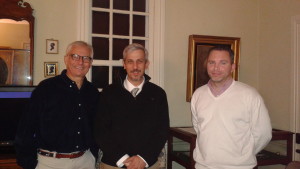
President Lenny Wagner, Professor Richard Veit, and Vice President Mickey DiCamillo
New Jersey Cemeteries and Tombstones: History in the Landscape
It was standing room only at the Smith-Cadbury mansion on Thursday night, January 28, when author and university professor Dr. Richard Veit gave an hour-long, humor-laced historical overview of graveyards, cemeteries, and notable graves in New Jersey. The appreciative audience learned about tombstone architecture going back to the 17th century, as well as materials used (granite, clay, tiles, ceramics, concrete – even plastic). Highlights of Dr. Veit’s talk included his numerous examples of grave markers, headstones, footstones, and mausoleums that told stories about the people buried there. Some were funny: “I told you I was sick,” read one tombstone. Another was somewhat humorous but sad: a tombstone for two brothers who died in 1693 noted they had both succumbed to mushroom poisoning despite repeated warnings by their elders to avoid the mushrooms. Typical juveniles! Yet another was simply tragic: one grave marker contained an epitaph to a woman who, in 1772, fell from a carriage and onto a blade she had been using to peel an apple. Just as interesting were the personalities illuminated by their graves. There was the immodest head stone inscription informing visitors that the grave’s occupant had been “The World’s Greatest Electrician.” A Roma cemetery featured a head stone paying tribute to a Roma couple who were community stalwarts, “Big G and Loveable Rose.” Some notable celebrities are buried in New Jersey: the infamous Aaron Burr, who killed Alexander Hamilton in a duel; and Dudley Moore, the famed actor, comic, and pianist. Dr. Veit discussed African-American burial grounds and the cemeteries of different immigrant groups, such as Italians and Jews. Poignantly, he concluded by warning of the challenges that many cemeteries and grave sites face: acid rain erosion, neglect, even vandalism. Dr. Veit, an Associate Professor in the Department of History and Anthropology at Monmouth University, based the presentation on his book, New Jersey Cemeteries and Tombstones: History in the Landscape (Rivergate Books, 2008).
-Elizabeth J. Rosenthal
 January 28, 2016@7:30pm
January 28, 2016@7:30pm
As part of its ongoing NJ History Speaker Series, The Historical Society presents Dr. Richard Veit who will discuss his book, New Jersey Cemeteries and Tombstones: History in the Landscape, on January 28 at 7:30 pm at the Smith-Cadbury Mansion, 12 High Street, Moorestown. New Jersey Cemeteries and Tombstones presents a culturally diverse account of New Jersey’s historic burial places from High Point to Cape May and from the banks of the Delaware to the ocean-washed shore, to explain what cemeteries tell us about people and the communities in which they lived. Dr. Veit is an Associate Professor in the Department of History and Anthropology at Monmouth University. He is the author of Digging New Jersey’s Past: Historical Archaeology in the Garden State, winner of the 2003 New Jersey Historic Preservation Award.
Free & open to the public. For more information contact moorestownhistory@verizon.net or 856-235-0353.

